You are using an out of date browser. It may not display this or other websites correctly.
You should upgrade or use an alternative browser.
You should upgrade or use an alternative browser.
BGVP DM8
- Added by Dsnuts
- Create date
Ace Bee
Headphoneus Supremus
Pros: Transparent mids
Note definition
Crisp + slightly warm notes
Smooth highs with details
Punchy and clean midbass
Excellent imaging and soundstage depth
Excellent assortment of tips
Excellent assortment of connectors
Note definition
Crisp + slightly warm notes
Smooth highs with details
Punchy and clean midbass
Excellent imaging and soundstage depth
Excellent assortment of tips
Excellent assortment of connectors
Cons: Subbass roll off
Slightly off bass tonality
Average stage width and height
Slightly off bass tonality
Average stage width and height
When I first learned I was getting a chance to be a part of a review tour of BGVP DM8, I was excited to say the least. I have used 2 other BGVP iems in the past: Artmagic VG4 and Artmagic DH3. While now I do not have any of them, I can remember clearly that I loved them when I had them.
But I am in, what you say, “Less is More” club. When driver count increases I automatically become sceptical at the sound, as I suspect not much effort has been put in tuning rather than increasing driver count. However, because it’s BGVP, I kept an open mind. And...well, I found out I wasn’t wrong keeping my mind open!
Specification:
Model: DM8
Driver: 8 Knowles + Sonion balanced armature driver unit
Ultra-high frequency: Knowles*2
High frequency: Knowles *2
Medium frequency: Sonion*1, Knowles*1
Low frequency: Sonion*2
Sensitivity: ≥110dB SPL/mW
Input impedance: 12Ω
Frequency response: 10Hz-40kHz
Distortion: <0.5%
Channel difference: <1dB
Rated power: 9mW
Cavity material: Nicefit resin, Egger bright paint
Cable length: 1.2m±5%
Disclaimer:
The unit has been sent to me from BGVP as a part of a review circle. I am not working or affiliated to BGVP and I am not being paid or influenced otherwise to say anything positive or negative about this review. All thoughts and opinions are my own.
Note: My opinions are based on price, category, personal experience, and personal expectations and are subjective in nature.

Build Quality and Comfort:
No compromise here, the iem feels solid and looks amazingly beautiful in the transparent shell, displaying all the drivers. Even though it houses 8 BA drivers, the housing is quite, I repeat, quite small comparatively, and gives a very good snug fit inside the ear. The shiny faceplates only add to the aesthetic appeal more.

Sound Impression:
I was surprised, to say the least, when I put them in my ears and played a song. The overall sound signature is very balanced, with a pronounced bass, very good midrange presence, and nice treble. It’s a gentle W shaped sound, at least to my ears.
Low:
Honestly, I wasn’t expecting such an impactful midbass punch when I put these on. But that’s how DM8 reproduced the lower frequencies. It was quite pleasing to my ear - strong punch, authoritative presence, very good texture. Never heard better BA midbass at this price range.
But that feeling of awe slightly falters when it comes to subbass. The subbass rumble is not bad at all, quite audible. But it has a slight roll off that prohibits it from reaching to the deepest registers, and restrains it from sounding as natural as DD bass, retaining the unmistakable BA tonality. Although not much of a trade-off, because if you are used to listening to only BA iems you will be more than satisfied. But coming from DD, you will feel something is off - in spite of the voluminous presence, the fullness of DD is still lacking.
But most importantly , there are very good layers of bass - it isn’t one note. And that should compensate the shortcomings well.
In Battlestar Galactica Season 2 OST: Prelude To War the drums sound strong but fast, giving out a strong punch then disappearing quickly. That helps keeping the stage clean, but sounds a bit unnatural nonetheless.
In The Dark Knight OST: Why So Serious? the ultra low notes which start right after 03:25 timing mark are reproduced with a good presence, but the DD physicality could not be found, which takes away the character.
In Muse - Showbiz and Steven Wilson - To The Bone the bass guitars have a nice rumbling presence with very good texture, but also do not fill up the space much - clean and well-tuned.

Mid:
This is where DM8 shines. This is where DM8 outperforms most others. This is DM8’s stronghold. Okay, enough adjectives, let’s get on to it.
The strength of DM8 in its midrange is its note definition and transparency. They are very good, to say the least. All the notes have very good depth and they stand out markedly, and yet they are refined enough not to sound harsh. It is quite a unique trait of DM8, sounding crisp yet refined, not grainy or harsh. Electric guitars sound crunchy yet not harsh.
The lower midrange has a notable touch of warmth. It’s not a very slight touch, mind it. Because of this, the male vocals have the required weight and sound quite natural. However, very occassionally, I found the snare rolls to be a touch too warm for my liking, same goes for other string instruments - cello, viola, bass; notes sound slightly warmer than my liking. But still quite transparent, hence nothing much to split my hairs on, so mostly they go unnoticed.
However, to my pleasant surprise, this warmth is not carried forward to the upper mids. Hence, female vocals retain their original musicality and convey the emotion perfectly. Electric guitars do not sound unnatural. A very very pleasing experience.
In Battlestar Galactica Season 2 OST: Prelude To War the snare rolls sound crisp and textured, notes are very well defined, with a noticeable hint of warmth.
In Poets Of The Fall - The Ballad Of Jeremiah Peacekeeper Mike Saaresto’s voice have the fullness and authoritative presence it so rightfully deserves. DM8 does not hold back in reproducing the textures also.
In Yao Si Ting - Scarborough Fair the voice of Yao Si Ting comes out beautifully with all its sizzle in ample quantity - sounds totally magical.

High:
BGVP has tuned the upper registers very cautiously, such that the energy is there in a moderate quantity and the highs are not in your face, but also do not feel claustrophobic or subdued. Transparent, crisp, refined, no sibilance - this is how I will describe the highs. Treble has a good extension - no complaints there. The energy is comparatively more in the lower treble than in the upper treble. That helps toning down sibilance, but also tones down the shimmers a bit. The energy in highs is less than the energy in the mids, hence the highs sit behind the mids and seem to have slightly less air. But still there is plenty of air for treble to breathe freely.
In Muse - Showbiz the background cymbal rolls are reproduced cleanly while not sounding piercing.
The track Metallica - The Four Horsemen sound sufficiently bright yet not harsh to the ear.

Soundstage and separation:
This is a mixed bag on DM8. DM8 exhibits a splendid separation and imaging of different instruments in a busy track. Each different instrument and vocal can be easily pinpointed within the headspace it creates. They are all stacked neatly from front to back.
However, the overall soundstage feels slightly narrow. It extends very well in depth, but feels restrained in width and height. Hence, the hint of holographic feel is there, but not the grand expanse of stage. Although not much of an issue, as the excellent separation does not make the overall presentation congested.
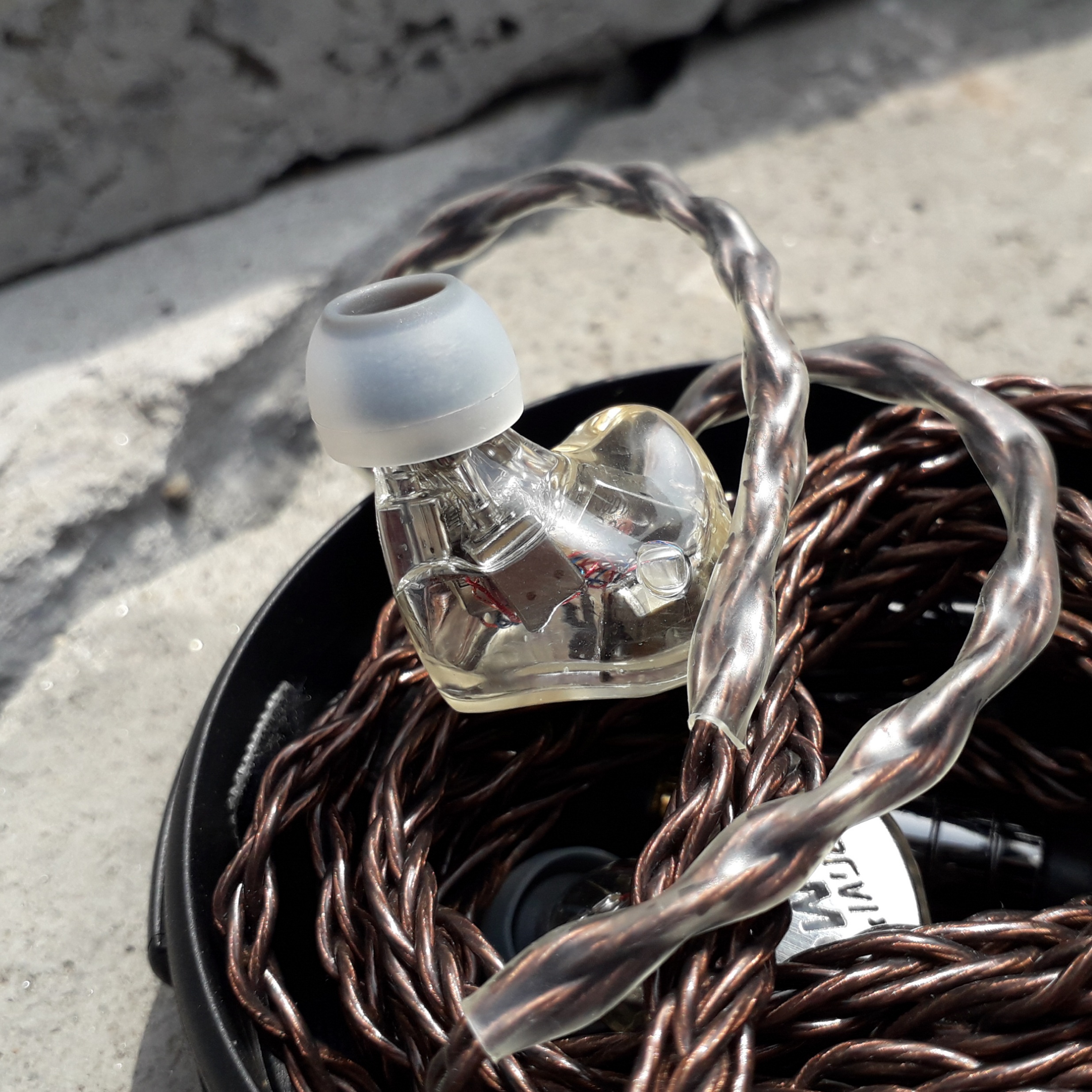
Comparison:
Vs. Unique Melody 3DT($349) - UM 3DT is my current daily driver, and I am sufficiently smitten by it, to say the least. Fundamentally, 3DT and DM8 are vastly different: 3DT houses 3 DD, two for bass and one for mids and highs. Whereas DM8 houses 8 BA drivers to take care of the whole spectrum. Understandably, the sound signature differs too.
DM8 has slightly more pronounced microdetails or microdynamics. 3DT also reproduces all of the microdetails quite effortlessly, just not as prominent as DM8.
In terms of bass, 3DT trumps DM8, hands down! I am yet to experience the sweet, highly satisfactory, and yet controlled bass that 3DT gives out. DM8's bass, while pretty good for BA, does not hold a candle to 3DT's bass.
Midrange is another story. DM8's midrange is more forward than 3DT, has a slightly warmer tonality. Whereas, 3DT has a slightly more v shaped signature in terms of mids. Mids of 3DT have neutral-cold tonality, which, to my ear, sounds extremely pleasing. Not so cold that sounds unnatural, not so warm that it sounds thick. Transparency of notes is more or less similar on both, whereas note definition is better on DM8 by a hair’s breadth.
3DT has slightly more energy in highs. Extension is similar on both, not much difference. Here also the notes have a similar neutral cold tonality as compared to DM8, but DM8 also does not sound unnatural - very balanced.
3DT has a more expansive and more airy stage than DM8, it extends more in height and width. But DM8 has a deeper stage - the instruments are stacked very well from forward to backward.
Although, DM8 takes the cake in imaging. The placement of different instruments inside the headspace is a touch better on DM8.
In short, 3DT draws you more into the music, whereas DM8 presents all the fine details effortlessly. Different modus operandi altogether, and both excel equally in their respective fields.

Conclusion:
If it is not evident by now, I love the DM8. The sound it produces is so balanced - mids are in focus, punchy and full BA bass, and very nice highs with plenty of energy in perfect balance with the rest of the spectrum. Honestly, DM8 ticks a lot of boxes. Mids are crisp, and details are produced effortlessly. Highs are also crisp but not sharp or piercing, details are there in abundance. Bass is the best I have heard from a BA driver till date. Very articulated notes that grab your attention without being uncomfortable. It is perhaps the first time I am being so much impressed by a full BA iem at this price range. Except the subbass, I never felt even a touch of dissatisfaction in any part of the rest of the spectrum. Really a very complete iem.
But I am in, what you say, “Less is More” club. When driver count increases I automatically become sceptical at the sound, as I suspect not much effort has been put in tuning rather than increasing driver count. However, because it’s BGVP, I kept an open mind. And...well, I found out I wasn’t wrong keeping my mind open!
Specification:
Model: DM8
Driver: 8 Knowles + Sonion balanced armature driver unit
Ultra-high frequency: Knowles*2
High frequency: Knowles *2
Medium frequency: Sonion*1, Knowles*1
Low frequency: Sonion*2
Sensitivity: ≥110dB SPL/mW
Input impedance: 12Ω
Frequency response: 10Hz-40kHz
Distortion: <0.5%
Channel difference: <1dB
Rated power: 9mW
Cavity material: Nicefit resin, Egger bright paint
Cable length: 1.2m±5%
Disclaimer:
The unit has been sent to me from BGVP as a part of a review circle. I am not working or affiliated to BGVP and I am not being paid or influenced otherwise to say anything positive or negative about this review. All thoughts and opinions are my own.
Note: My opinions are based on price, category, personal experience, and personal expectations and are subjective in nature.

Build Quality and Comfort:
No compromise here, the iem feels solid and looks amazingly beautiful in the transparent shell, displaying all the drivers. Even though it houses 8 BA drivers, the housing is quite, I repeat, quite small comparatively, and gives a very good snug fit inside the ear. The shiny faceplates only add to the aesthetic appeal more.

Sound Impression:
I was surprised, to say the least, when I put them in my ears and played a song. The overall sound signature is very balanced, with a pronounced bass, very good midrange presence, and nice treble. It’s a gentle W shaped sound, at least to my ears.
Low:
Honestly, I wasn’t expecting such an impactful midbass punch when I put these on. But that’s how DM8 reproduced the lower frequencies. It was quite pleasing to my ear - strong punch, authoritative presence, very good texture. Never heard better BA midbass at this price range.
But that feeling of awe slightly falters when it comes to subbass. The subbass rumble is not bad at all, quite audible. But it has a slight roll off that prohibits it from reaching to the deepest registers, and restrains it from sounding as natural as DD bass, retaining the unmistakable BA tonality. Although not much of a trade-off, because if you are used to listening to only BA iems you will be more than satisfied. But coming from DD, you will feel something is off - in spite of the voluminous presence, the fullness of DD is still lacking.
But most importantly , there are very good layers of bass - it isn’t one note. And that should compensate the shortcomings well.
In Battlestar Galactica Season 2 OST: Prelude To War the drums sound strong but fast, giving out a strong punch then disappearing quickly. That helps keeping the stage clean, but sounds a bit unnatural nonetheless.
In The Dark Knight OST: Why So Serious? the ultra low notes which start right after 03:25 timing mark are reproduced with a good presence, but the DD physicality could not be found, which takes away the character.
In Muse - Showbiz and Steven Wilson - To The Bone the bass guitars have a nice rumbling presence with very good texture, but also do not fill up the space much - clean and well-tuned.

Mid:
This is where DM8 shines. This is where DM8 outperforms most others. This is DM8’s stronghold. Okay, enough adjectives, let’s get on to it.
The strength of DM8 in its midrange is its note definition and transparency. They are very good, to say the least. All the notes have very good depth and they stand out markedly, and yet they are refined enough not to sound harsh. It is quite a unique trait of DM8, sounding crisp yet refined, not grainy or harsh. Electric guitars sound crunchy yet not harsh.
The lower midrange has a notable touch of warmth. It’s not a very slight touch, mind it. Because of this, the male vocals have the required weight and sound quite natural. However, very occassionally, I found the snare rolls to be a touch too warm for my liking, same goes for other string instruments - cello, viola, bass; notes sound slightly warmer than my liking. But still quite transparent, hence nothing much to split my hairs on, so mostly they go unnoticed.
However, to my pleasant surprise, this warmth is not carried forward to the upper mids. Hence, female vocals retain their original musicality and convey the emotion perfectly. Electric guitars do not sound unnatural. A very very pleasing experience.
In Battlestar Galactica Season 2 OST: Prelude To War the snare rolls sound crisp and textured, notes are very well defined, with a noticeable hint of warmth.
In Poets Of The Fall - The Ballad Of Jeremiah Peacekeeper Mike Saaresto’s voice have the fullness and authoritative presence it so rightfully deserves. DM8 does not hold back in reproducing the textures also.
In Yao Si Ting - Scarborough Fair the voice of Yao Si Ting comes out beautifully with all its sizzle in ample quantity - sounds totally magical.

High:
BGVP has tuned the upper registers very cautiously, such that the energy is there in a moderate quantity and the highs are not in your face, but also do not feel claustrophobic or subdued. Transparent, crisp, refined, no sibilance - this is how I will describe the highs. Treble has a good extension - no complaints there. The energy is comparatively more in the lower treble than in the upper treble. That helps toning down sibilance, but also tones down the shimmers a bit. The energy in highs is less than the energy in the mids, hence the highs sit behind the mids and seem to have slightly less air. But still there is plenty of air for treble to breathe freely.
In Muse - Showbiz the background cymbal rolls are reproduced cleanly while not sounding piercing.
The track Metallica - The Four Horsemen sound sufficiently bright yet not harsh to the ear.

Soundstage and separation:
This is a mixed bag on DM8. DM8 exhibits a splendid separation and imaging of different instruments in a busy track. Each different instrument and vocal can be easily pinpointed within the headspace it creates. They are all stacked neatly from front to back.
However, the overall soundstage feels slightly narrow. It extends very well in depth, but feels restrained in width and height. Hence, the hint of holographic feel is there, but not the grand expanse of stage. Although not much of an issue, as the excellent separation does not make the overall presentation congested.

Comparison:
Vs. Unique Melody 3DT($349) - UM 3DT is my current daily driver, and I am sufficiently smitten by it, to say the least. Fundamentally, 3DT and DM8 are vastly different: 3DT houses 3 DD, two for bass and one for mids and highs. Whereas DM8 houses 8 BA drivers to take care of the whole spectrum. Understandably, the sound signature differs too.
DM8 has slightly more pronounced microdetails or microdynamics. 3DT also reproduces all of the microdetails quite effortlessly, just not as prominent as DM8.
In terms of bass, 3DT trumps DM8, hands down! I am yet to experience the sweet, highly satisfactory, and yet controlled bass that 3DT gives out. DM8's bass, while pretty good for BA, does not hold a candle to 3DT's bass.
Midrange is another story. DM8's midrange is more forward than 3DT, has a slightly warmer tonality. Whereas, 3DT has a slightly more v shaped signature in terms of mids. Mids of 3DT have neutral-cold tonality, which, to my ear, sounds extremely pleasing. Not so cold that sounds unnatural, not so warm that it sounds thick. Transparency of notes is more or less similar on both, whereas note definition is better on DM8 by a hair’s breadth.
3DT has slightly more energy in highs. Extension is similar on both, not much difference. Here also the notes have a similar neutral cold tonality as compared to DM8, but DM8 also does not sound unnatural - very balanced.
3DT has a more expansive and more airy stage than DM8, it extends more in height and width. But DM8 has a deeper stage - the instruments are stacked very well from forward to backward.
Although, DM8 takes the cake in imaging. The placement of different instruments inside the headspace is a touch better on DM8.
In short, 3DT draws you more into the music, whereas DM8 presents all the fine details effortlessly. Different modus operandi altogether, and both excel equally in their respective fields.

Conclusion:
If it is not evident by now, I love the DM8. The sound it produces is so balanced - mids are in focus, punchy and full BA bass, and very nice highs with plenty of energy in perfect balance with the rest of the spectrum. Honestly, DM8 ticks a lot of boxes. Mids are crisp, and details are produced effortlessly. Highs are also crisp but not sharp or piercing, details are there in abundance. Bass is the best I have heard from a BA driver till date. Very articulated notes that grab your attention without being uncomfortable. It is perhaps the first time I am being so much impressed by a full BA iem at this price range. Except the subbass, I never felt even a touch of dissatisfaction in any part of the rest of the spectrum. Really a very complete iem.
Last edited:
RoXor
New Head-Fier
Pros: 1. Excellent bass performance.
2. Good mid-range.
3. Smooth detailed highs.
4. Good soundstage and excellent imaging.
5. Very good build quality and premium accessories.
2. Good mid-range.
3. Smooth detailed highs.
4. Good soundstage and excellent imaging.
5. Very good build quality and premium accessories.
Cons: 1. Treble could have more extension and air
2. I have had fit issues, which was solved with Azla Sedna Airfit Light short tips
2. I have had fit issues, which was solved with Azla Sedna Airfit Light short tips

Disclaimer:
The unit has been sent to me from BGVP as a part of a review circle. I am not working or affiliated to BGVP and I am not being paid or influenced otherwise to say anything positive or negative about this review. All thoughts and opinions are my own.
Note: Please note that my opinions and ratings are based on price, category, market competition and personal expectations and are subjective in nature.
Build Quality and comfort
The DM8 looks beautiful in its transparent shell, and you get to see the 8 BAs inside. DM8 is a all BA iem, with a crossover design, 8BAs taking care of different sound frequencies. The retail packaging comes with a great bundle of accessories – a 2.5mm thick frozen UPOCC 6N 8-strand single crystal copper 24awg handmade litz cable, 2.5mm to 3.5mm connector, 2.5mm to 4.4mm connector, various assortment of tips which can fine tune the sound signature, a tin container to store the IEMs,
Score: 9/10

Lows
It’s a common convention that BA-only IEMs can’t do bass that well, surely we have had flagship IEMs that broke this convention, but DM8 has really outdone it in the mid-fi category. DM8s bass is strong and punchy, impactful and sounds like a dynamic driver. It’s not overwhelming, rather very satisfying as it takes care of that appetite for bass that we have. The bass doesn’t bleed into mids, neither over emphasized to call it a bassy IEM. Sub-bass is great and has good grip on the overall low frequencies. The lows are textured and detailed, and has really good quality. The bass is slightly boosted but in the best quantity possible with great quality.
Score: 9/10
Mids
Midrange is smooth and slightly laid back in the DM8. It sounds natural to my ears. Upper midrange has slightly more energy comparatively. It’s well detailed but non-fatiguing at the same time.
Score: 8.5/10
Highs
Highs in the DM8 is clean and smooth. It has good really good amount of details and decent amount of air in the top end. Treble extensions could have been slightly better and could have had more air in the top end. Overall, its still really good and does better than most of the IEMs in this range. It has good amount of macro details but manages to be smooth at the same time.
Score: 8.5/5
Soundstage, Imaging, Separation
Soundstage of DM8 has good width and depth, and helps keep enough space for instrument heavy tracks to not sound congested. The imaging was really good for an IEM to be able to pinpoint each instrument and identify even the how distant those were placed. It has good instrument separation and I believe DM8 performs in this area way better than most other IEMs in this range. The layering is decent in DM8 too.
9/10
Source and drivability
I believe neutral to warm sources will pair well with DM8. I have Ibasso’s DX160 and Pico Power amp. Both Ibasso DX160 PO and DX160 (lineout) to Pico Power paired well with DM8, however Pico Power improves the bass performance and makes the presentation musical and euphonic.
DM8 is a low impedance high sensitivity IEM, although less sensitive than CA Andromeda. Power wise they can be driven off mobile phone but I would recommend a good source, atleast a decent dongle DAC as DM8 is a very capable IEM.
Conclusion:
I previously owned BGVP DM6 which was a well received IEM during its time, although had mixed reactions due to its V shaped sound and the efforts it takes in terms of source matching, cable and tip rolling to make it sound best. I went that extra mile and I was well rewarded, I still love that IEM and I don’t think any other IEM could have taken its place, not for that price. I had high hopes on BGVP as a brand, I didn’t get to try the DM7 or BGVPs other offerings, but I was lucky enough to get to review the DM8. And I can happily say that BGVP has delivered to my expectations, and this time without me needing to go that extra mile for the DM8 to sound good. It has a mature tuning, one that of the likes of flagships IEMs. It has excellent package of accessories, really good build quality and sounds excellent. There’s always room for improvement and hence the same will always reflect on the score, DM8 is going to be my highest rated IEM among the ones that I have reviewed so far, DM8 is a complete package and offers great value for money.
Overall rating: 9/10

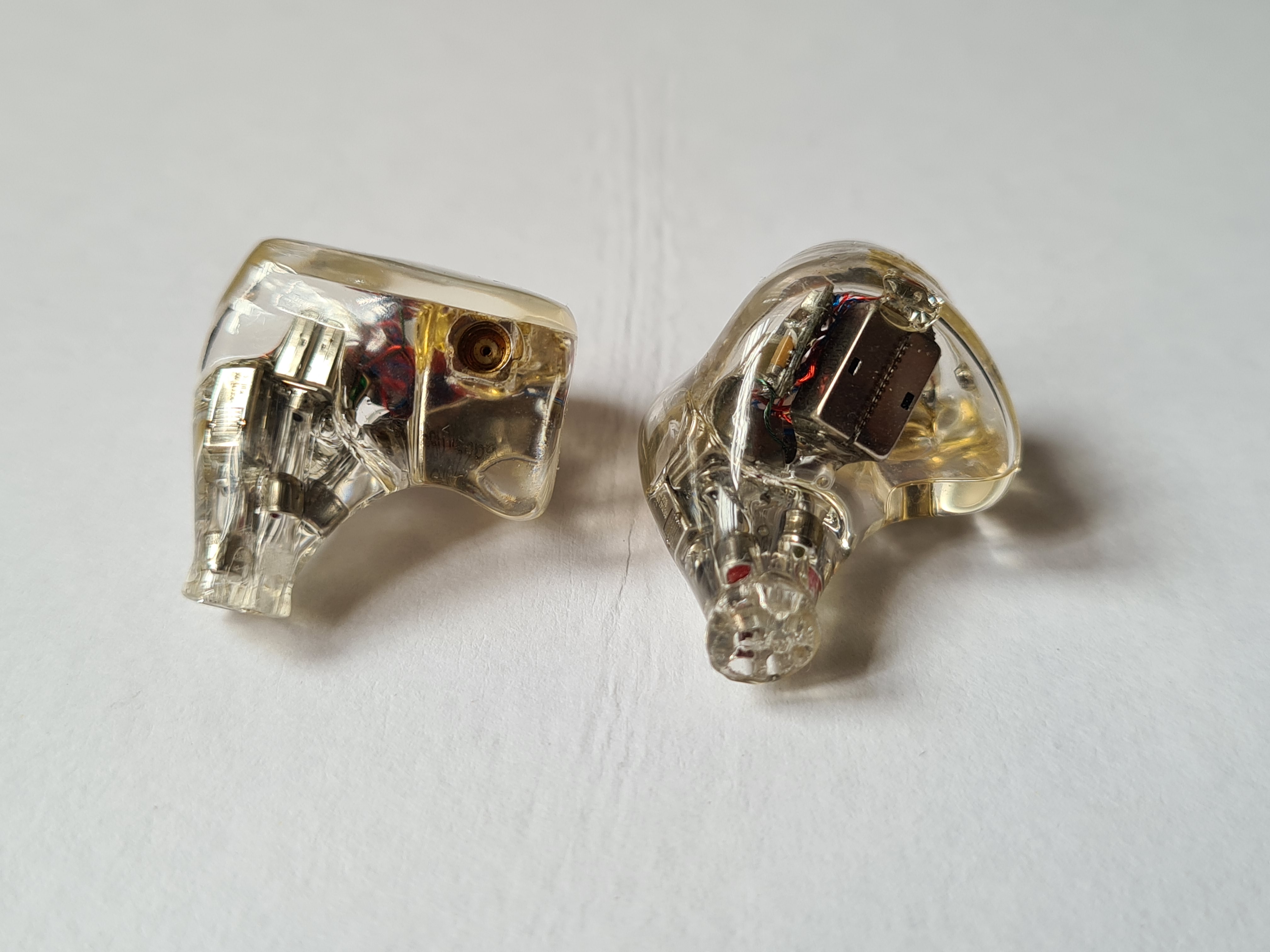


SoundChoice
Great review, thank you. I too have the great-fitting DM6 and really appreciate it for stage use its isolation, imaging, and separation. Is the DM8 a step up over the DM6 in these factors?
EuphoniousMedia
New Head-Fier
Pros: Easy to drive.
Energetic bass for an all BA set.
Stellar imaging.
Cable with 3.5mm and 4.4mm adaptors.
Plethora of tips.
Energetic bass for an all BA set.
Stellar imaging.
Cable with 3.5mm and 4.4mm adaptors.
Plethora of tips.
Cons: Shells lack the aesthetics and refinement.
Default cable is very heavy.
Average soundstage.
Early Treble roll off.
Default cable is very heavy.
Average soundstage.
Early Treble roll off.
Introduction :
BGVP is a quite a known contender when it comes to making universal as well as customized in ear monitors. BGVP was formed in 2015 and they are famous for their “All BA” sets like DM6, DM7 and their latest flagshipmDM8 which is what we are reviewing here today. They have received a lot of positive feedback for DM7 in the past as well. BGVP makes IEMs ranging from 80$ to all the way up to 2,000$, their ArtMagic series are specialized electrostatic custom in ear monitors made for vocalists and working professionals.
Disclaimer :
The review was tested at 350$ and all the judgement was made keeping the exact same price in mind. We're not responsible for any price change that might alter this review.
This item was graciously provided by BGVP for review in exchange for an honest and unbiased review. The review was written by the team in our own accord and no thoughts or judgements were altered in any way.
Purchasable link :
HiFiGo (Global Market)
Penon Audio (Global Market)
Specifications :

Unboxing and Accessories :

When it comes to unboxing DM8, BGVP has nailed this one. The box is small yet packs accessories which are more than needed. The cover has fluidic shades of orange and blue which resembles the wood version of DM8 (which costs 30$ more). After sliding the cover you have a box which contains all the accessories fitted nicely in foam. Box accessory set includes:
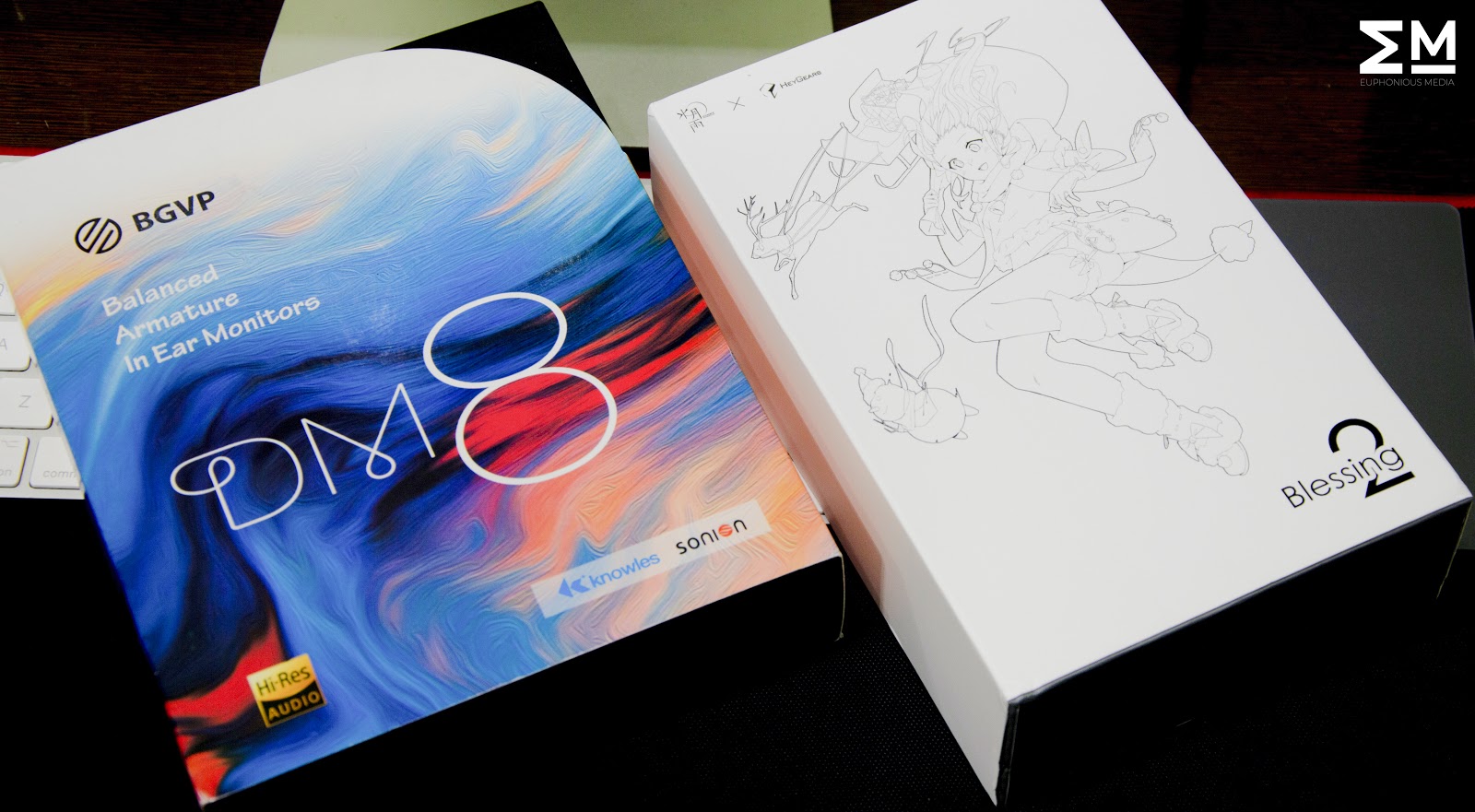
The included adaptors make the default wire very versatile making it possible to pair with any DAP/AMP. The included tips are presented greatly in a holder. Memory foam tips do an amazing job and everything feels like quality. This type of unboxing experience is expected from other competitors as well and BGVP has set the benchmark at 350$ as they know how to provide accessories.
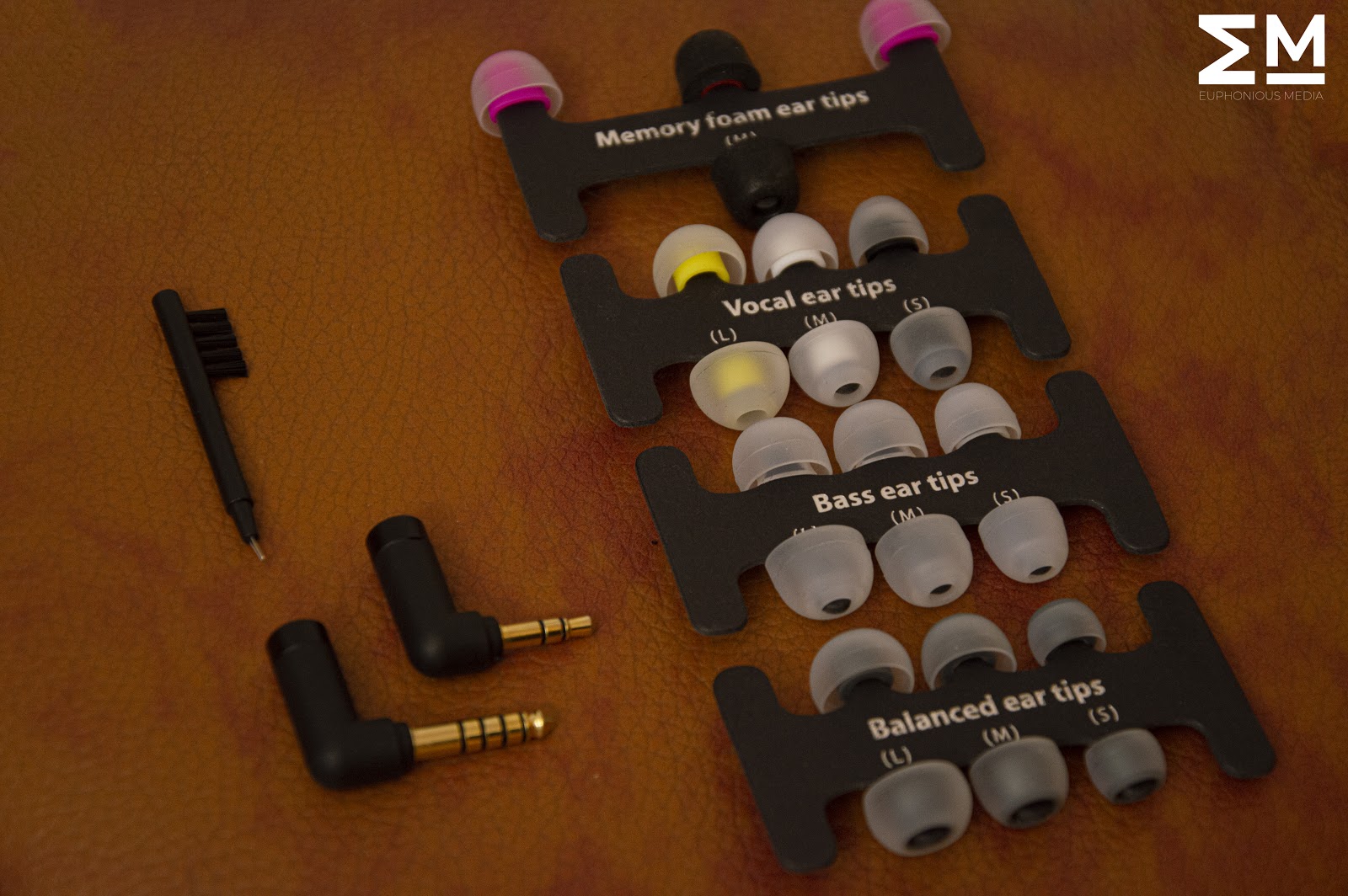
Cable :
Cable that comes with the box is a 2.5mm balanced cable along with adaptors which make it a really versatile cable to go along with any DAP or AMP. The only drawback of this cable is that it’s pretty heavy and the ear guides have sharp corners and lack a little bit of refinement. It’s a MMCX cable and material of choice BGVP went with, is copper. It has a rubberised texture to it, the cable braiding feels secure and tight. The Y-split is made out of aluminium and the chin slider works pretty well. The connector has an aluminium cladding on which “BGVP” is etched. There were a few microphonics with the provided cable.
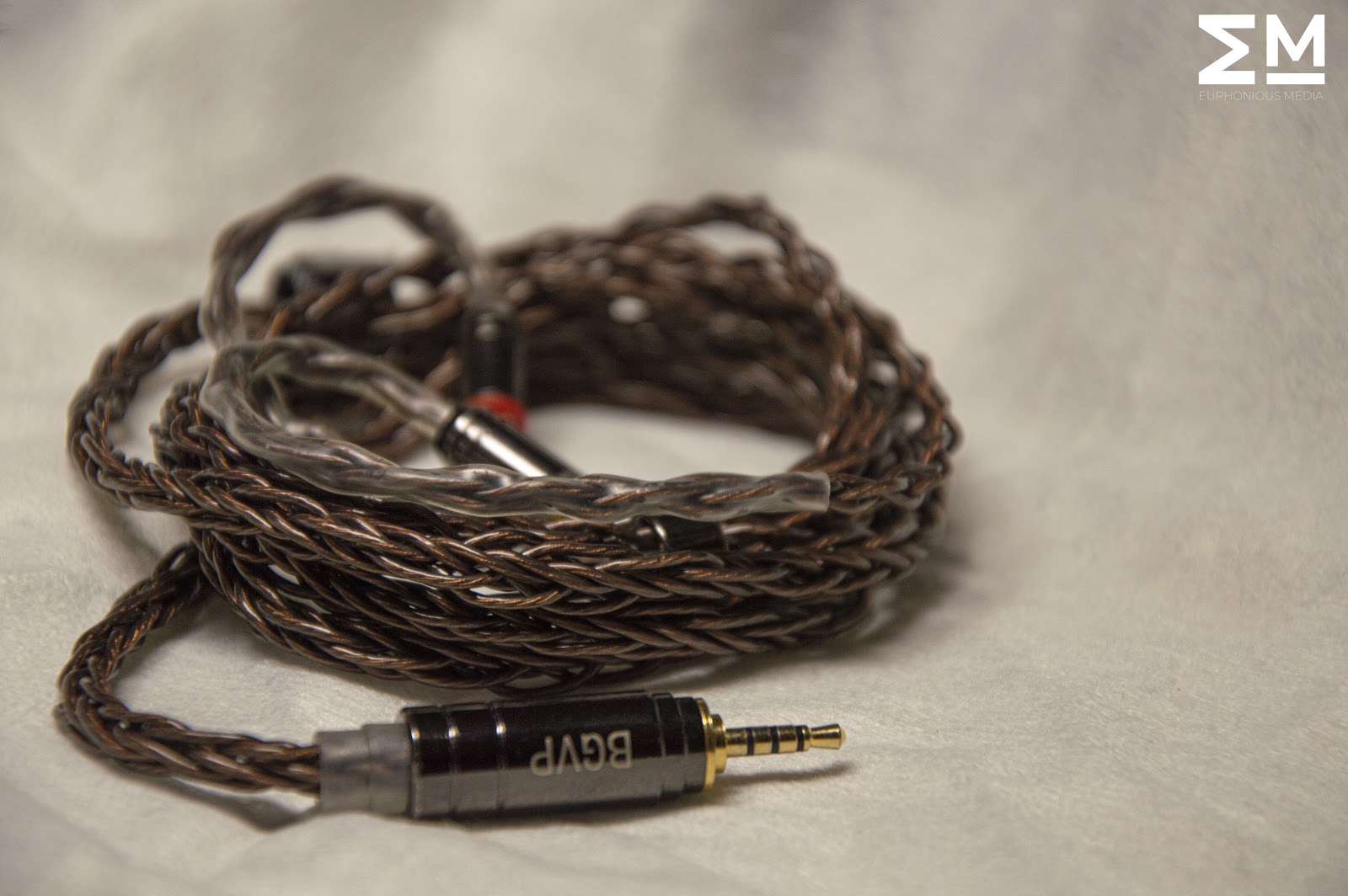
Case :
Nothing fancy here, it’s a round case with BGVP branding on top of it. Inside is covered with micro fabric to protect IEMs. Its a very small and easily pocketable case and cannot fit anything apart from IEMs, sorry dongle DACs!
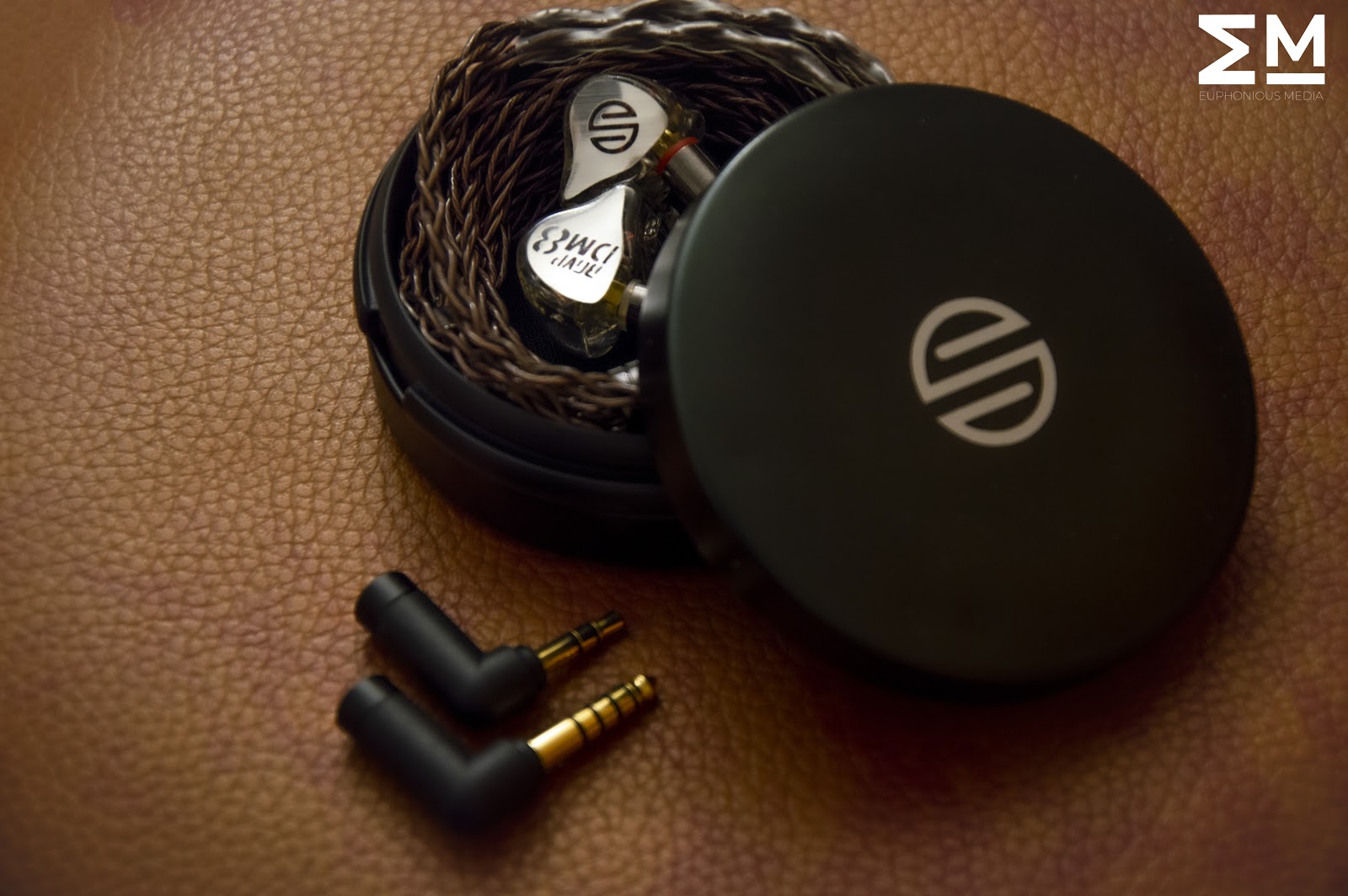
IEM quality and fit :
The IEMs are made out of acrylic which are hollow in nature unlike Moondrop Blessing’s 2 which are filled with resin that give them heft and sturdiness. The DM8 comes in two variants, Transparent clear and Stabilized wood. The faceplate had unpolished edges, the aesthetics and quality felt not so great for the price considering we have Blessing 2 which has solid build quality.
The fit of DM8 was great, nothing was uncomfortable for long usage neither did they create any sort of pressure inside ears.
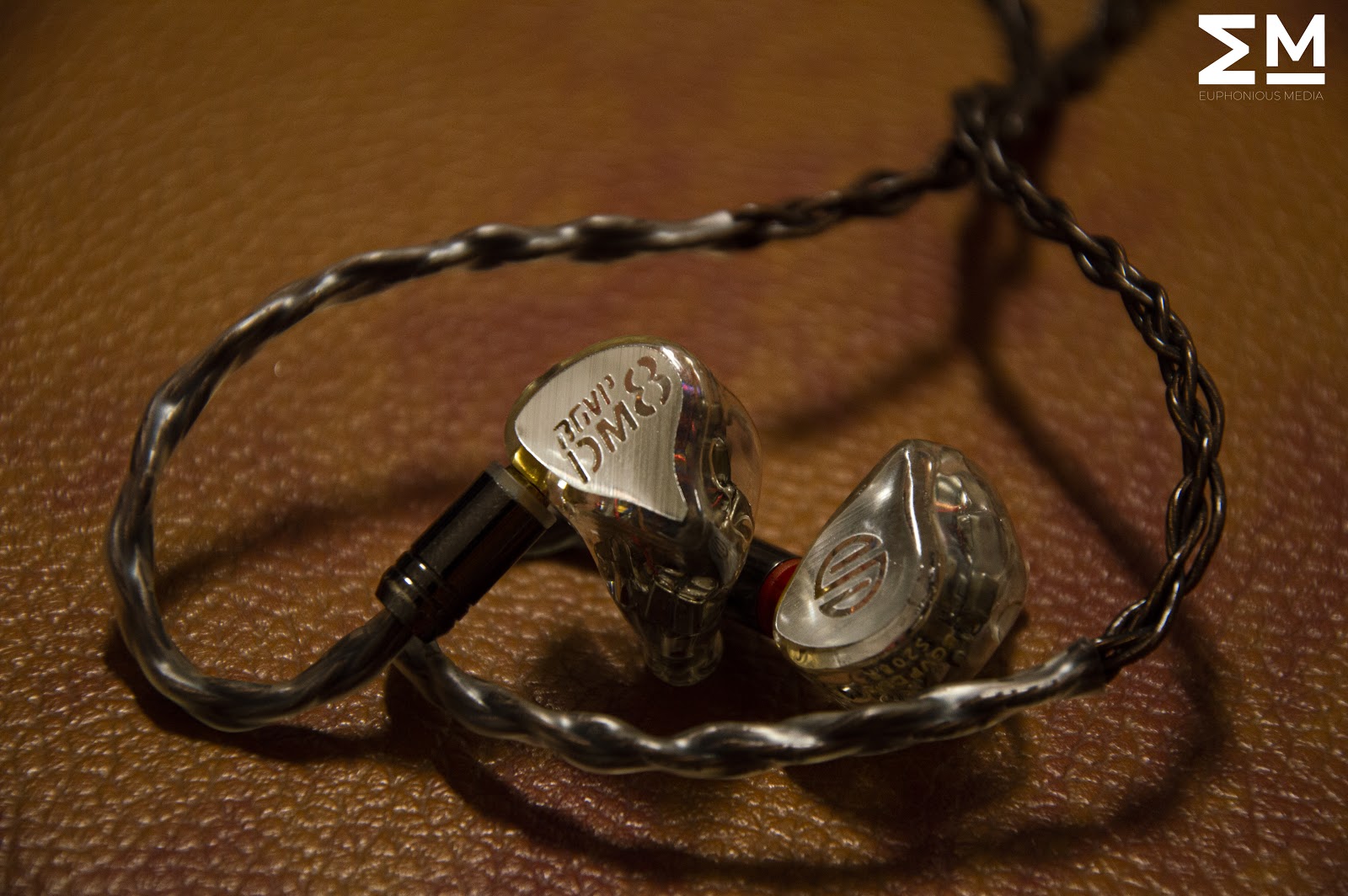
Sound Isolation :
The DM8 are built from acrylic resin and do an amazing job blocking outside noise. With the default pair of eartips the seal achieved was satisfactory. They isolate sound very well considering the fact that they are made out of resin. One shouldn’t be concerned about isolation on this pair.
The Driveability and sources used :
BGVP DM8 are fairly easy to drive, with only 12 Ohms of impedance and sensitivity of 110dB they are easily driven off by any source. They are quite sensitive IEMs and you will be benefited from a clean signal output. A good DAC/AMP combination is recommended as it was quite evident in testing with FiiO Q5 on balanced it does scale really well. Being easy to drive we were still able to reach 70% on Q5 and they were steady as a rock, they didn’t increase in volume much but they did have an impact on both left and right extensions.
Sources used are :
Sound :
Bass (5/5) :
This came as a shocker, owing to its build and driver setup we were not expecting the bass to be this good, DM8 has a 8 BA setup and the overall reproduction of bass is punchy and crisp, the drum kicks and that deep engulfing bass almost feels life-like. The details and texture of the bass is on point, lower bass is present but never for a second we thought it overpowers the presentation, the bass extends very well and is satisfying overall. Mid bass packs a solid punch, instruments really pop out to life and if eyes are closed one can be fooled to be present on the stage listening to live music as the bass is so precise and fast, highly recommended to people who enjoy listening to instrumental music, believe us this IEM does justice to the music, this is the kind of bass that we expect from an IEM and this does a fantastic job of portraying the sheer perfection in terms of bass representation to sum it up - No More No Less, Perfect It Is !!!
Mids (4.5/5) :
One thing we have noticed during the trial of many IEM that if the all BA setup is tuned well the overall sound uplifts which is the case here right from the very beginning the bass being spot on it's time to talk about the vocals, just like the bass the vocal representation is very natural and slight front set. Lower mids are tuned so well that it does not make the vocals sound too hefty but also does not make the vocals sound thin and tinny as some of the IEMs out there do. Higher mids see a bit of dip due to which we think that female vocals experience slight warm sounding but nevertheless vocals sound very natural and does not feel artificial, as compared to the music and instruments that music has the overall perception of vocal are right in the center position of the staging right in the head which makes them sound very natural. For the given price what these offer, we think that it does check almost every possible box present. Slight change in upper mids and they can expect all 5 stars from Team EM.
Treble (4/5) :
The overall signature that we think is close to being warm and natural in the way this IEM portrays the vocals and highs, being a bit warmer we feel there is a slight dip on the higher side of the spectrum, there is an early roll off on the highs and it does not feel so sparkly and bright sounding as we expected on the basis the driver configuration, again shocked by the overall presumptions we had prior, but again the overall presentation is very natural and life like. Higher range of treble is lacking making the sound not exciting and we really want BGVP to work on this and if this gets fixed there is no stopping it to beat some big contenders in the market.
Imaging (4.5/5) :
The separation and placement of instruments feels like to be in a sphere and the detail retrieval is just beyond the words can describe. Vocals take center staging and the instruments sound exactly where they are being played, the most emphasizing thing about the imaging is top level instruments sound on top of head which is very rare to find but it does portray these according to the recording. In conclusion the imaging is stellar but if highs can be fixed a little bit then the imaging would also improve.
Sound Stage (4/5) :
Staging on these are the only thing that makes us think that this needs to be worked on. At the first go nobody can tell that these have average soundstage as the imaging is so good anybody can be easily fooled by that, but spending some time with the IEM and playing some various tracks it became evident that there is a lack in sense of space and grandeur. Playing Hans Zimmer's OST tracks from Inception and Interstellar it became evident that the width of the stage is not so wide but surprisingly the height depiction is stellar at the same time, soundstage can be a very big factor in purchasing the IEM, but we recommend going for this IEM as an overall package is of great value.
BGVP DM8 Vs Moondrop Blessing 2 :
When it comes to overall unboxing and accessories, the DM8 punches way above Moondrop Blessing 2. Moondrop Blessing 2 lacks the accessories that DM8 comes with. DM8 comes with a balanced cable, better case and better tips overall. The build quality of Blessing 2 is far superior than that of DM8. They feel more expensive and tastefully done.
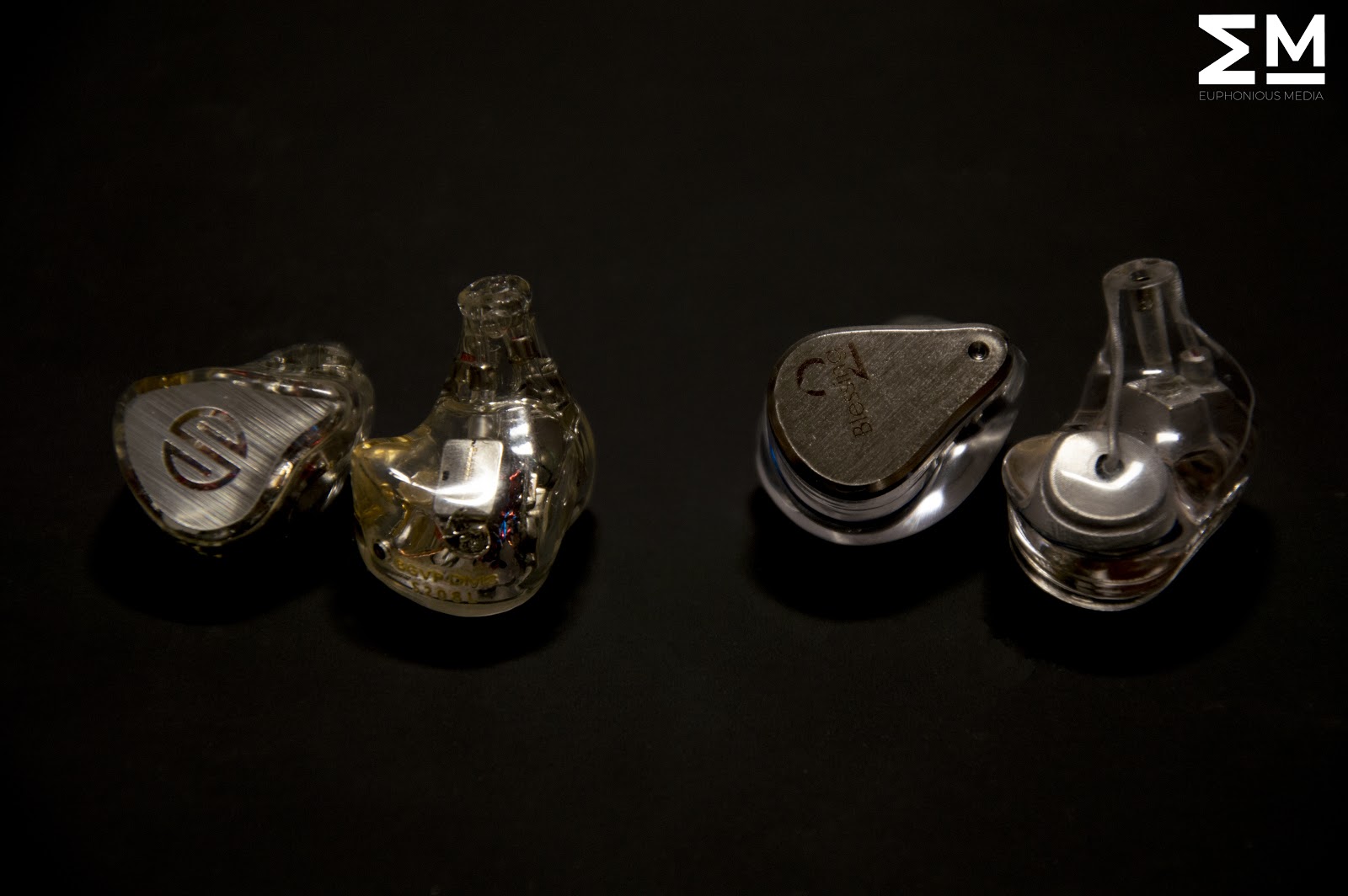
Bass :
The bass is obviously better on DM8, it makes the sound seem very rich and smooth, on the other hand moondrop does a very good job of portraying the neutral sound but it can sound thin sometimes due to that. Bass obviously goes to DM8.
Mids :
Vocals both come neck to neck but we would give the edge to the Blessing 2 as the overall instruments and vocals are inline which is not the case with the DM 8 which has the tendency to keep vocals in front in each of the songs played.
Treble :
Highs is the area where Blessing 2 easily defeats the DM 8, male and female vocals sound much better in comparison and the overall signature is slightly brighter which makes it reveal a lot more in terms of detail and sounds more sparkly, crisp.
Imaging :
Imaging is actually amazing on both but again instruments sound more realistic on Blessing 2 so a slight edge to be given on that to Moondrop for that alone, separation is almost same on both so it can be considered a tie.
Sound stage :
Moondrop has actually nailed this region and it is miles better if compared to any other competition leave alone DM 8, it is actually the very opposite of DM8, the stage and grandeur is huge to that extent that it blows away the competition.
Conclusion :
Considering both are almost similar in price we think they sound so similar yet so different in their own regards. It boils down to personal preference now, if you are someone who likes neutral sounding IEM then Blessing 2 can be your affair otherwise if you like a little warmer sound with great bass DM8 is the way to go!

Conclusion :
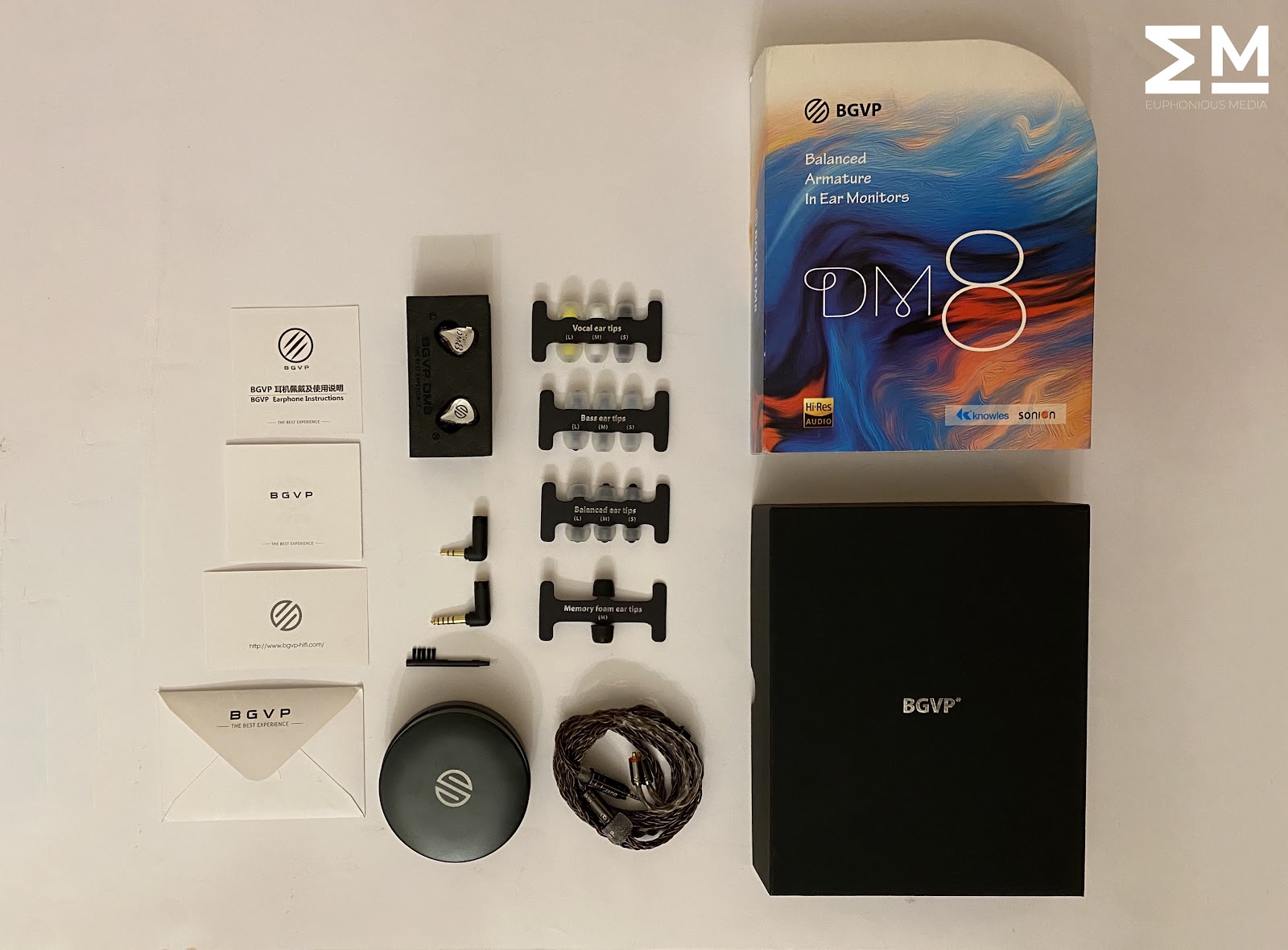
The latest flagship from BGVP, DM8 costs 350$ and it's definitely not cheap, they have entered a very competitive market in this price point where there are perfect contenders like Moondrop Blessing 2 and they do deliver up to the expectations. DM8 is a well accessorised, well tuned IEM and definitely ticks all the boxes. All genres of music sound fantastic on this pair and you cannot go wrong with it. While it certainly doesn't hold the title for "Best IEM under 500$" but it clearly does what it is supposed to do and that is to sound energetic, enjoyable and smooth.
Rated :

All grades are given keeping price to performance ratio in mind, better grade doesn't mean it's the best.
BGVP is a quite a known contender when it comes to making universal as well as customized in ear monitors. BGVP was formed in 2015 and they are famous for their “All BA” sets like DM6, DM7 and their latest flagshipmDM8 which is what we are reviewing here today. They have received a lot of positive feedback for DM7 in the past as well. BGVP makes IEMs ranging from 80$ to all the way up to 2,000$, their ArtMagic series are specialized electrostatic custom in ear monitors made for vocalists and working professionals.
Disclaimer :
The review was tested at 350$ and all the judgement was made keeping the exact same price in mind. We're not responsible for any price change that might alter this review.
This item was graciously provided by BGVP for review in exchange for an honest and unbiased review. The review was written by the team in our own accord and no thoughts or judgements were altered in any way.
Purchasable link :
HiFiGo (Global Market)
Penon Audio (Global Market)
Specifications :
Unboxing and Accessories :
When it comes to unboxing DM8, BGVP has nailed this one. The box is small yet packs accessories which are more than needed. The cover has fluidic shades of orange and blue which resembles the wood version of DM8 (which costs 30$ more). After sliding the cover you have a box which contains all the accessories fitted nicely in foam. Box accessory set includes:
- DM8
- IEM carry case
- 10 pair of tips
- 2.5mm MMCX wire
- 3.5mm and 4.4mm Adaptor
- Cleaning tool
The included adaptors make the default wire very versatile making it possible to pair with any DAP/AMP. The included tips are presented greatly in a holder. Memory foam tips do an amazing job and everything feels like quality. This type of unboxing experience is expected from other competitors as well and BGVP has set the benchmark at 350$ as they know how to provide accessories.
Cable :
Cable that comes with the box is a 2.5mm balanced cable along with adaptors which make it a really versatile cable to go along with any DAP or AMP. The only drawback of this cable is that it’s pretty heavy and the ear guides have sharp corners and lack a little bit of refinement. It’s a MMCX cable and material of choice BGVP went with, is copper. It has a rubberised texture to it, the cable braiding feels secure and tight. The Y-split is made out of aluminium and the chin slider works pretty well. The connector has an aluminium cladding on which “BGVP” is etched. There were a few microphonics with the provided cable.
Case :
Nothing fancy here, it’s a round case with BGVP branding on top of it. Inside is covered with micro fabric to protect IEMs. Its a very small and easily pocketable case and cannot fit anything apart from IEMs, sorry dongle DACs!
IEM quality and fit :
The IEMs are made out of acrylic which are hollow in nature unlike Moondrop Blessing’s 2 which are filled with resin that give them heft and sturdiness. The DM8 comes in two variants, Transparent clear and Stabilized wood. The faceplate had unpolished edges, the aesthetics and quality felt not so great for the price considering we have Blessing 2 which has solid build quality.
The fit of DM8 was great, nothing was uncomfortable for long usage neither did they create any sort of pressure inside ears.
Sound Isolation :
The DM8 are built from acrylic resin and do an amazing job blocking outside noise. With the default pair of eartips the seal achieved was satisfactory. They isolate sound very well considering the fact that they are made out of resin. One shouldn’t be concerned about isolation on this pair.
The Driveability and sources used :
BGVP DM8 are fairly easy to drive, with only 12 Ohms of impedance and sensitivity of 110dB they are easily driven off by any source. They are quite sensitive IEMs and you will be benefited from a clean signal output. A good DAC/AMP combination is recommended as it was quite evident in testing with FiiO Q5 on balanced it does scale really well. Being easy to drive we were still able to reach 70% on Q5 and they were steady as a rock, they didn’t increase in volume much but they did have an impact on both left and right extensions.
Sources used are :
- DDHiFi 3.5 mm to lightning
- FiiO Q5
- FiiO BTR5
Sound :
Bass (5/5) :
This came as a shocker, owing to its build and driver setup we were not expecting the bass to be this good, DM8 has a 8 BA setup and the overall reproduction of bass is punchy and crisp, the drum kicks and that deep engulfing bass almost feels life-like. The details and texture of the bass is on point, lower bass is present but never for a second we thought it overpowers the presentation, the bass extends very well and is satisfying overall. Mid bass packs a solid punch, instruments really pop out to life and if eyes are closed one can be fooled to be present on the stage listening to live music as the bass is so precise and fast, highly recommended to people who enjoy listening to instrumental music, believe us this IEM does justice to the music, this is the kind of bass that we expect from an IEM and this does a fantastic job of portraying the sheer perfection in terms of bass representation to sum it up - No More No Less, Perfect It Is !!!
Mids (4.5/5) :
One thing we have noticed during the trial of many IEM that if the all BA setup is tuned well the overall sound uplifts which is the case here right from the very beginning the bass being spot on it's time to talk about the vocals, just like the bass the vocal representation is very natural and slight front set. Lower mids are tuned so well that it does not make the vocals sound too hefty but also does not make the vocals sound thin and tinny as some of the IEMs out there do. Higher mids see a bit of dip due to which we think that female vocals experience slight warm sounding but nevertheless vocals sound very natural and does not feel artificial, as compared to the music and instruments that music has the overall perception of vocal are right in the center position of the staging right in the head which makes them sound very natural. For the given price what these offer, we think that it does check almost every possible box present. Slight change in upper mids and they can expect all 5 stars from Team EM.
Treble (4/5) :
The overall signature that we think is close to being warm and natural in the way this IEM portrays the vocals and highs, being a bit warmer we feel there is a slight dip on the higher side of the spectrum, there is an early roll off on the highs and it does not feel so sparkly and bright sounding as we expected on the basis the driver configuration, again shocked by the overall presumptions we had prior, but again the overall presentation is very natural and life like. Higher range of treble is lacking making the sound not exciting and we really want BGVP to work on this and if this gets fixed there is no stopping it to beat some big contenders in the market.
Imaging (4.5/5) :
The separation and placement of instruments feels like to be in a sphere and the detail retrieval is just beyond the words can describe. Vocals take center staging and the instruments sound exactly where they are being played, the most emphasizing thing about the imaging is top level instruments sound on top of head which is very rare to find but it does portray these according to the recording. In conclusion the imaging is stellar but if highs can be fixed a little bit then the imaging would also improve.
Sound Stage (4/5) :
Staging on these are the only thing that makes us think that this needs to be worked on. At the first go nobody can tell that these have average soundstage as the imaging is so good anybody can be easily fooled by that, but spending some time with the IEM and playing some various tracks it became evident that there is a lack in sense of space and grandeur. Playing Hans Zimmer's OST tracks from Inception and Interstellar it became evident that the width of the stage is not so wide but surprisingly the height depiction is stellar at the same time, soundstage can be a very big factor in purchasing the IEM, but we recommend going for this IEM as an overall package is of great value.
BGVP DM8 Vs Moondrop Blessing 2 :
When it comes to overall unboxing and accessories, the DM8 punches way above Moondrop Blessing 2. Moondrop Blessing 2 lacks the accessories that DM8 comes with. DM8 comes with a balanced cable, better case and better tips overall. The build quality of Blessing 2 is far superior than that of DM8. They feel more expensive and tastefully done.
Bass :
The bass is obviously better on DM8, it makes the sound seem very rich and smooth, on the other hand moondrop does a very good job of portraying the neutral sound but it can sound thin sometimes due to that. Bass obviously goes to DM8.
Mids :
Vocals both come neck to neck but we would give the edge to the Blessing 2 as the overall instruments and vocals are inline which is not the case with the DM 8 which has the tendency to keep vocals in front in each of the songs played.
Treble :
Highs is the area where Blessing 2 easily defeats the DM 8, male and female vocals sound much better in comparison and the overall signature is slightly brighter which makes it reveal a lot more in terms of detail and sounds more sparkly, crisp.
Imaging :
Imaging is actually amazing on both but again instruments sound more realistic on Blessing 2 so a slight edge to be given on that to Moondrop for that alone, separation is almost same on both so it can be considered a tie.
Sound stage :
Moondrop has actually nailed this region and it is miles better if compared to any other competition leave alone DM 8, it is actually the very opposite of DM8, the stage and grandeur is huge to that extent that it blows away the competition.
Conclusion :
Considering both are almost similar in price we think they sound so similar yet so different in their own regards. It boils down to personal preference now, if you are someone who likes neutral sounding IEM then Blessing 2 can be your affair otherwise if you like a little warmer sound with great bass DM8 is the way to go!
Conclusion :
The latest flagship from BGVP, DM8 costs 350$ and it's definitely not cheap, they have entered a very competitive market in this price point where there are perfect contenders like Moondrop Blessing 2 and they do deliver up to the expectations. DM8 is a well accessorised, well tuned IEM and definitely ticks all the boxes. All genres of music sound fantastic on this pair and you cannot go wrong with it. While it certainly doesn't hold the title for "Best IEM under 500$" but it clearly does what it is supposed to do and that is to sound energetic, enjoyable and smooth.
Rated :
All grades are given keeping price to performance ratio in mind, better grade doesn't mean it's the best.
iceperry
New Head-Fier
Pros: Gorgeous Wood shell, Technical Ability, Musical Layering, Midrange tonality
Cons: Huge shell and nozzle, Warm Coloured Sound (Preference dependent)
Intro

Disclaimer: This review set is a demo set graciously lent to me by Daniel at Oardio and the review is written of my own accord and all thoughts are my own. The BGVP DM8 is available for purchase from Oardio through their website should you find yourself interested in a pair.
For more reviews like this, do drop by our website: www.perrivanaudio.com
BGVP made waves with their release of the DM6 to much fanfare a few years back. They have not looked back since and have been working hard on releases such as the ArtMagic lines. The release of the DM8 replaces the DM7 as the flagship Pure BA IEM with 8 balanced armature drivers (Sonion+Knowles) per side. It comes in 2 shell options, resin or stabilised wood. CIEM shells are available on request at a premium. (resin shell only of course)

Accessories and Build Quality (Score: 9/10)

The packaging and accessories are as expected of the price tag of the DM8. It has the aesthetic and style of a polished product and is overall rather impressive. There is a wide selection of tips available, neatly arranged like clothes hanging on a clothes rack.

Build Quality and Aesthetics are what separates the DM8 from its peers in its price range. The stabilised wood shell each possess a unique design and the colours are so eye-catchingly vibrant. This is the most beautiful pair of IEMs I have laid my hands on for under $500. BGVP certainly went all out on this one. My only complaint would be that I prefer a 2-pin connection over the MMCX but it seems MMCX has been their connector of choice since the beginning.

Fit (Score: 7/10)

The version I reviewed is the wood one, which is only available in a universal fit. I struggled a little with getting a comfortable fit as these are huge, understandably so given the wood material and the 8 BAs per side. The nozzle is one of the widest I’ve had experience with and felt like they were enlarging my ear canals. Nevertheless, I managed to get them fit snugly after some fiddling and found myself enjoying them without having to worry about them breaking the seal.
I’m sure the customised resin version would be much more comfortable should you find yourself looking for a pair of CIEMs.
Sound (Score: 9.0/10)
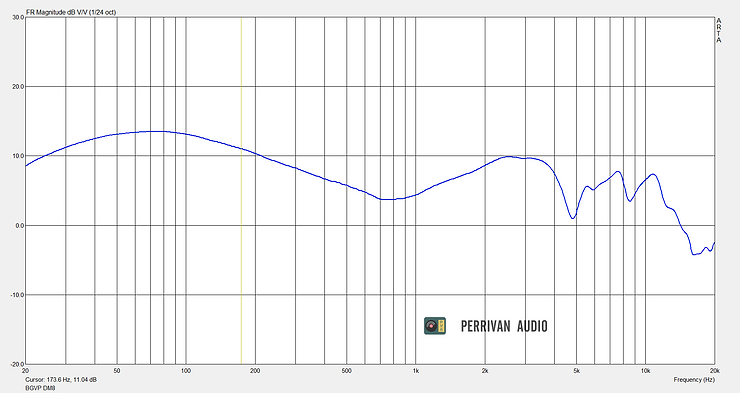
Sources Used
Bass (Score: 9/10)
There is a noticeable Midbass hump but no messy bloat or bleed. The bass remains clean and stable and instruments and parts demonstrate excellent separation and layering. Although I personally prefer a more sub-bass focused bass, the bass on the DM8 still performs very well, providing a great supporting foundation to the sound signature. Those who cannot live without the sub-bass extension and crisp, weighted punch of a DD would need some adjustment. Despite that, the DM8 does well with the bass slam and punch, coming rather close to the rumble that one typically finds on well-tuned dynamic driver IEMs.
Bass is silky smooth when the situation calls for it and has a very organic decay. The elevated bass response gives a very warm sound, which may be a plus or not depending on personal preference. The attack of the Bass guitar notes on Scary Pockets is quite on point, with a nice punchy texture complemented by a smooth natural decay.
Mids (Score: 9.5/10)
My favourite part of the DM8’s sound is the mids. The mid-centric nature of the sound shines through and really comes through. Vocals very airy and textured and the imaging and staging gives it a really immersive "3D experience". Both female and male vocals have decent weight and body to them and never come close to being harsh or thin. (Scary Pockets – Stand By Me & Valerie)
The tonality and timbre of instruments are… sumptuous and just so enjoyable. Brass instrumentals on “Waiting on the World to Change” by Scary Pockets are so well positioned, layered and engaging.
The DM8’s real flex of technical ability is in the mids, achieving a resolving yet musical set that many higher-priced sets struggle to achieve.
Treble (Score: 8.5/10)
Treble is done tastefully. The highs are present but more laid back as compared to the upper mids. This makes the overall tonality much more pleasant and smooth and the music never gets too “in-your-face”. This was especially well-done considering how the sound is already rather heavy on the upper mids.
Jingles are a little 2D-sounding, not that much of that upper range shimmer, and instead has a more lower-treble focused sound. Laid back, not splashy. Once again, this comes down to preference. Treble sensitive listeners may prefer the treble on these, though I would’ve loved to see more upward extension. Nonetheless, the overall treble performance is still competent and complements the sound signature well.
Overall
In terms of soundstage, I would classify the DM8 as average in its class. It has a pretty nice width, with a rather accurate positioning and separation of instruments but just wish there was a little more extension in the treble at both extreme ends as the sound can get a little cramped at times when I wanted a more expansive atmospheric sound.
Imaging and layering are what the DM8 excelled for me. Everything was layered well and it was so so satisfying, just like admiring a perfectly stacked Jenga tower or pyramid. The coherency and fluidity of the sound is something that many more expensive sets fail to achieve.
One potentially divisive point of the DM8s is that the sound is rather coloured. It isn’t the most tonally accurate especially when talking about the timbre of wind and string instruments.
Comparison
Thieaudio Legacy 5
Legacy 5 sounds overly intimate, which the DM8 deftly avoids. The bass on the Legacy 5 is also a little boomier and less controlled despite having the dynamic driver. The highs on the DM8 are also more expansive and extended. Overall, I would say the DM8 is a much more “whole” product than the Legacy 5, justifiably so since it is almost double the price of the L5.
Conclusion

The midrange performance and the overall coherence of the DM8 are the two main standout factors of the DM8 and those two are alone for me to say these truly have the X-Factor.
My biggest sources of apprehension towards the DM8s are the finicky fit (due to my smaller than average ears) and the durability of the MMCX connectors. However, BGVP has shown pretty excellent customer support recently so that should put to rest most of my worries.
Overall, the BGVP DM8 is a polished product that is worthy of its TOTL title of the Pure BA Driver line. It holds its own in its own price tier and I very much prefer the DM8 in some of my side-by-side comparisons with higher-priced IEMs like the IBasso IT04 and the FIR Audio 5x5.

Disclaimer: This review set is a demo set graciously lent to me by Daniel at Oardio and the review is written of my own accord and all thoughts are my own. The BGVP DM8 is available for purchase from Oardio through their website should you find yourself interested in a pair.
For more reviews like this, do drop by our website: www.perrivanaudio.com
BGVP made waves with their release of the DM6 to much fanfare a few years back. They have not looked back since and have been working hard on releases such as the ArtMagic lines. The release of the DM8 replaces the DM7 as the flagship Pure BA IEM with 8 balanced armature drivers (Sonion+Knowles) per side. It comes in 2 shell options, resin or stabilised wood. CIEM shells are available on request at a premium. (resin shell only of course)

Accessories and Build Quality (Score: 9/10)

The packaging and accessories are as expected of the price tag of the DM8. It has the aesthetic and style of a polished product and is overall rather impressive. There is a wide selection of tips available, neatly arranged like clothes hanging on a clothes rack.

Build Quality and Aesthetics are what separates the DM8 from its peers in its price range. The stabilised wood shell each possess a unique design and the colours are so eye-catchingly vibrant. This is the most beautiful pair of IEMs I have laid my hands on for under $500. BGVP certainly went all out on this one. My only complaint would be that I prefer a 2-pin connection over the MMCX but it seems MMCX has been their connector of choice since the beginning.

Fit (Score: 7/10)

The version I reviewed is the wood one, which is only available in a universal fit. I struggled a little with getting a comfortable fit as these are huge, understandably so given the wood material and the 8 BAs per side. The nozzle is one of the widest I’ve had experience with and felt like they were enlarging my ear canals. Nevertheless, I managed to get them fit snugly after some fiddling and found myself enjoying them without having to worry about them breaking the seal.
I’m sure the customised resin version would be much more comfortable should you find yourself looking for a pair of CIEMs.
Sound (Score: 9.0/10)

Frequency Response for the DM8
Sources Used
- Hiby R5
- Lotoo Paw S1
- Itzhak Perlman
- Broods – Free
- Why Don’t We – The Good Times and The Bad Ones
- 10cm – 4.0
- Michael Bublé
- Gryffin
- NEEDTOBREATHE
- Scary Pockets
- Boston Symphony Orchestra
Bass (Score: 9/10)
There is a noticeable Midbass hump but no messy bloat or bleed. The bass remains clean and stable and instruments and parts demonstrate excellent separation and layering. Although I personally prefer a more sub-bass focused bass, the bass on the DM8 still performs very well, providing a great supporting foundation to the sound signature. Those who cannot live without the sub-bass extension and crisp, weighted punch of a DD would need some adjustment. Despite that, the DM8 does well with the bass slam and punch, coming rather close to the rumble that one typically finds on well-tuned dynamic driver IEMs.
Bass is silky smooth when the situation calls for it and has a very organic decay. The elevated bass response gives a very warm sound, which may be a plus or not depending on personal preference. The attack of the Bass guitar notes on Scary Pockets is quite on point, with a nice punchy texture complemented by a smooth natural decay.
Mids (Score: 9.5/10)
My favourite part of the DM8’s sound is the mids. The mid-centric nature of the sound shines through and really comes through. Vocals very airy and textured and the imaging and staging gives it a really immersive "3D experience". Both female and male vocals have decent weight and body to them and never come close to being harsh or thin. (Scary Pockets – Stand By Me & Valerie)
The tonality and timbre of instruments are… sumptuous and just so enjoyable. Brass instrumentals on “Waiting on the World to Change” by Scary Pockets are so well positioned, layered and engaging.
The DM8’s real flex of technical ability is in the mids, achieving a resolving yet musical set that many higher-priced sets struggle to achieve.
Treble (Score: 8.5/10)
Treble is done tastefully. The highs are present but more laid back as compared to the upper mids. This makes the overall tonality much more pleasant and smooth and the music never gets too “in-your-face”. This was especially well-done considering how the sound is already rather heavy on the upper mids.
Jingles are a little 2D-sounding, not that much of that upper range shimmer, and instead has a more lower-treble focused sound. Laid back, not splashy. Once again, this comes down to preference. Treble sensitive listeners may prefer the treble on these, though I would’ve loved to see more upward extension. Nonetheless, the overall treble performance is still competent and complements the sound signature well.
Overall
In terms of soundstage, I would classify the DM8 as average in its class. It has a pretty nice width, with a rather accurate positioning and separation of instruments but just wish there was a little more extension in the treble at both extreme ends as the sound can get a little cramped at times when I wanted a more expansive atmospheric sound.
Imaging and layering are what the DM8 excelled for me. Everything was layered well and it was so so satisfying, just like admiring a perfectly stacked Jenga tower or pyramid. The coherency and fluidity of the sound is something that many more expensive sets fail to achieve.
One potentially divisive point of the DM8s is that the sound is rather coloured. It isn’t the most tonally accurate especially when talking about the timbre of wind and string instruments.
Comparison
Thieaudio Legacy 5
Legacy 5 sounds overly intimate, which the DM8 deftly avoids. The bass on the Legacy 5 is also a little boomier and less controlled despite having the dynamic driver. The highs on the DM8 are also more expansive and extended. Overall, I would say the DM8 is a much more “whole” product than the Legacy 5, justifiably so since it is almost double the price of the L5.
Conclusion

The midrange performance and the overall coherence of the DM8 are the two main standout factors of the DM8 and those two are alone for me to say these truly have the X-Factor.
My biggest sources of apprehension towards the DM8s are the finicky fit (due to my smaller than average ears) and the durability of the MMCX connectors. However, BGVP has shown pretty excellent customer support recently so that should put to rest most of my worries.
Overall, the BGVP DM8 is a polished product that is worthy of its TOTL title of the Pure BA Driver line. It holds its own in its own price tier and I very much prefer the DM8 in some of my side-by-side comparisons with higher-priced IEMs like the IBasso IT04 and the FIR Audio 5x5.
abheybir
500+ Head-Fier
Pros: 1. Great Micro detailing and timber
2. Musical yet Balanced Presentation
3. Amazing Bass for an all BA setup
4. Very well accessorized
2. Musical yet Balanced Presentation
3. Amazing Bass for an all BA setup
4. Very well accessorized
Cons: 1. Average soundstage
2. Bulky shells, can cause fit issues (Not in my case)
2. Bulky shells, can cause fit issues (Not in my case)
Introduction
DM8 is the latest flagship IEM by BGVP, a Chinese company mainly involved with customizing and producing high end Hifi earbuds, earphones and other electronic products.
DM8 spreads its charm right from its unboxing. It comes packed in a beautiful double box. The outer box has shiny surface with DM8 written over a colorful background along with other information about the IEM.
The inside box is of matte black finish with all in-box items meticulously placed.
In the box you would find a set of 10 ear-tips, an 8 stranded braided copper colored stock cable, a round
black box to keep the earphones safe and finally the earpieces. The box also has a cleaning brush, a 4.4mm balanced and a 3.5mm single-ended connector set along with a small white envelop that carries warranty card, manual and other essential documents.
The main connector of the wire is a rich looking chunky metallic cylinder with similar texture as that of end plug barrels and Y-split piece.
The IEM are available in 3 color variation- Blue-Pink, Woodcarving and transparent, I have received a transparent unit with a silver face-plate with BGVP logo printed on one and DM8 printed on the other as a part of review circle.
The Earpieces are bulky, 3D printed resin unit with a short nozzle. They are handcrafted, fully transparent body giving a glimpse of the technology they encapsulate. There is a tiny air-ventilation hole beneath the units.
All in-box items are premium looking and gets one excited as one opens it.
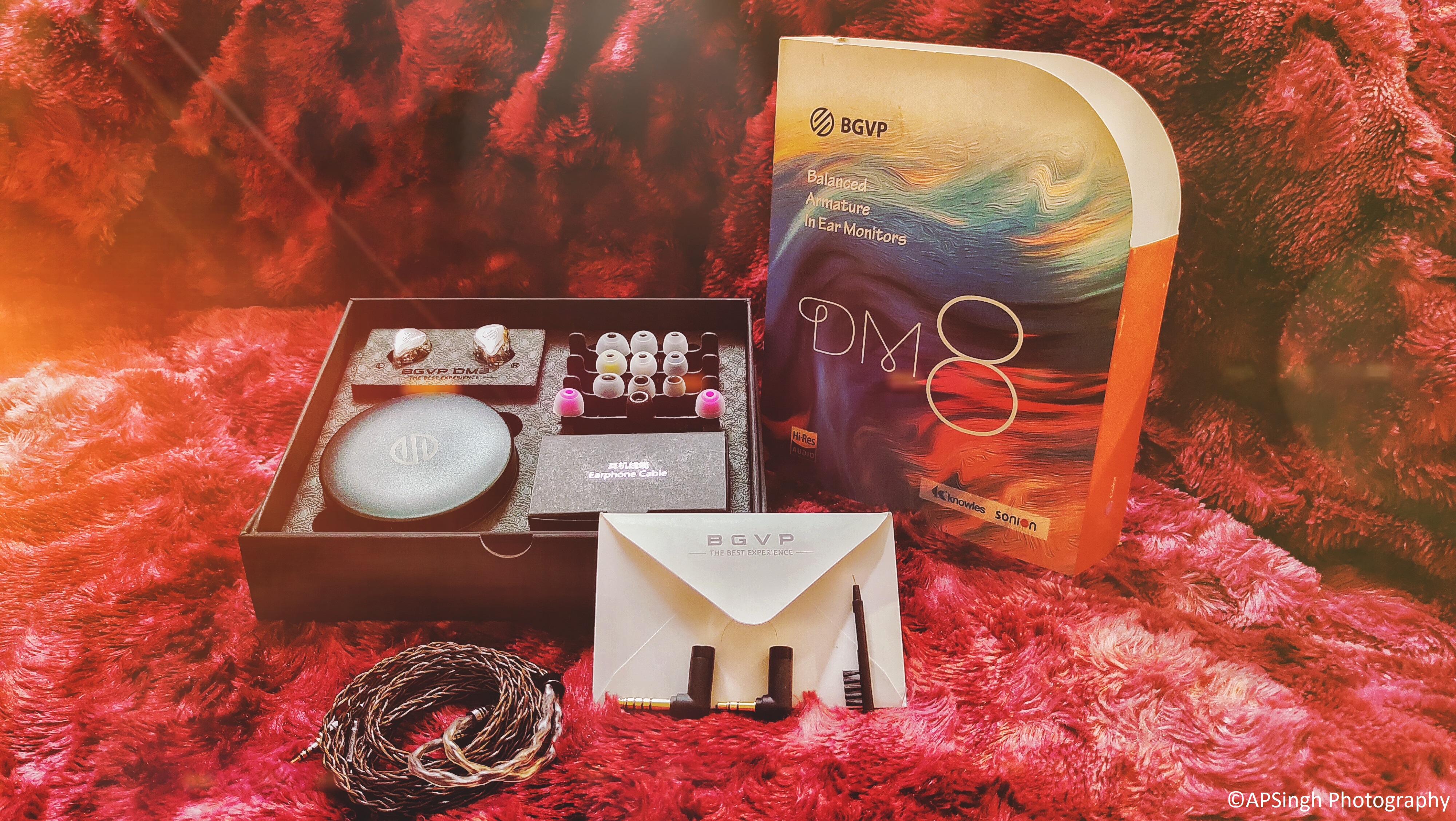
Package Contents:
• One pair of BGVP DM8 IEMs.
• One UPOCC 6N 8-strand single crystal copper 24awg MMCX cable with 2.5mm termination.
• 2.5mm to 3.5mm adapter.
• 2.5mm to 4.4mm adapter.
• One pair of Memory Foam ear tips.
• Nine pairs of silicone ear tips (3 pairs vocal, 3 pairs balanced, 3 pairs bass ear tips).
• Hard carry case.
Disclaimer:
I have received BGVP DM-8 as part of review circle sent from the brand itself in exchange of honest reviews. All impressions of sound are subjective to my own listening and my sources and is based on my experience with IEMs of similar hardware configurations and price range. You can read my other reviews on head-fi or my personal blog.

Sources:
For this review the unit has been paired to A&K SE100 (ES9038 Pro) and Fiio Q5 (AK4490), mostly using the balanced out without any other amplification.
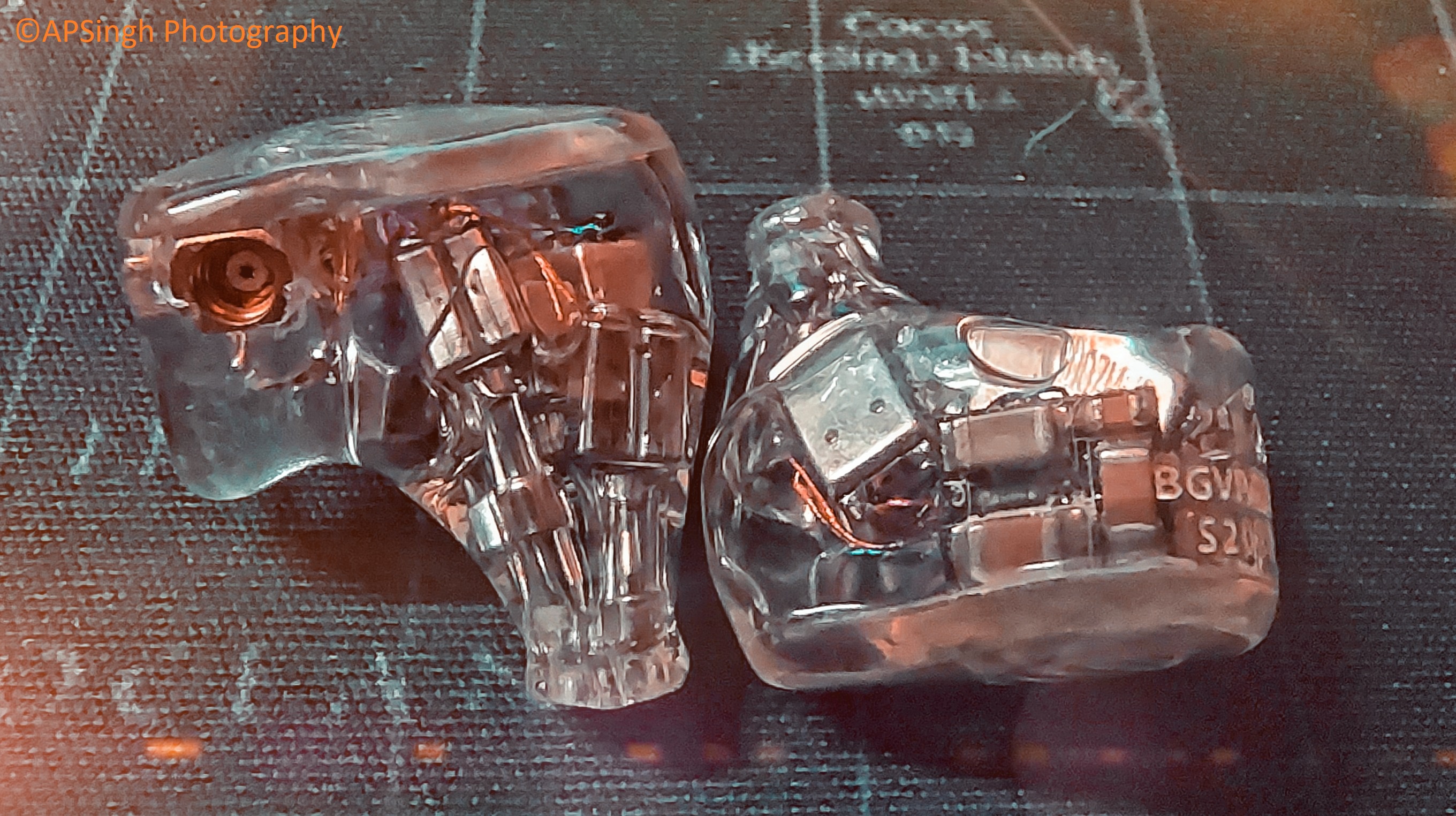
Highs:
Listening to the “Shape of My Heart by Sting” was the first experience I had on it, and it immediately made me fell in love with DM8, The way it filled complete headroom with all the airiness and microdetails was something heart touching.
DM8 has the perfect sparkling highs which one notices straight out of the box. There is no sibilance or harsh tones at any point of time. Treble response is well extended, and airiness is all around the headroom with crisp details and overall gives a balanced tuning at this spectrum range.
Mids:
The mid spectrum reproduction is very uniform and is one of the best tuned IEMs. The vocal presentation is amazing and natural. There is uniformity throughput the mids section, be it the lower mids or the upper mid-range spectrum. There is no bass bleed into mids and thus the detailing and timber is amazing. There is a feel of airiness and presence factor specially when listening to guitars, cymbals and trumpets.
I felt bit inclination towards warm tonality, the male vocals sound perfect while female vocals are sharp and overall results are crisp and upfront notes which fill the entire headroom and best example of this was felt while listening to “A million Dreams” cover by Peter Hollens.
Or be it the original “Beauty and the Best” soundtrack by Celine Dion, Peabo Bryson it literally connects one to the soul I must say. Not to forget my initial experience with “Shape of My Heart by Sting”.
Lows:
DM8 has an amazing bass response for a full BA architecture, the Bass response is punchy and has a nice slam to it. It is full bodied and have a nice texture. Even sub-bass region is not shy at all and easily reminds of any dynamic driver. The Bass is the third best thing about DM8 after micro-detailing and mids.
I enjoyed listening to my favorite bass-oriented track - “Tokyo Drift” by KVSH, the bass was tight and precise. I must say DM8 can bring any IEM with typical dynamic driver to shame by its bass response. A job well done in implementation of BA drivers. Kudos BGVP for this!!
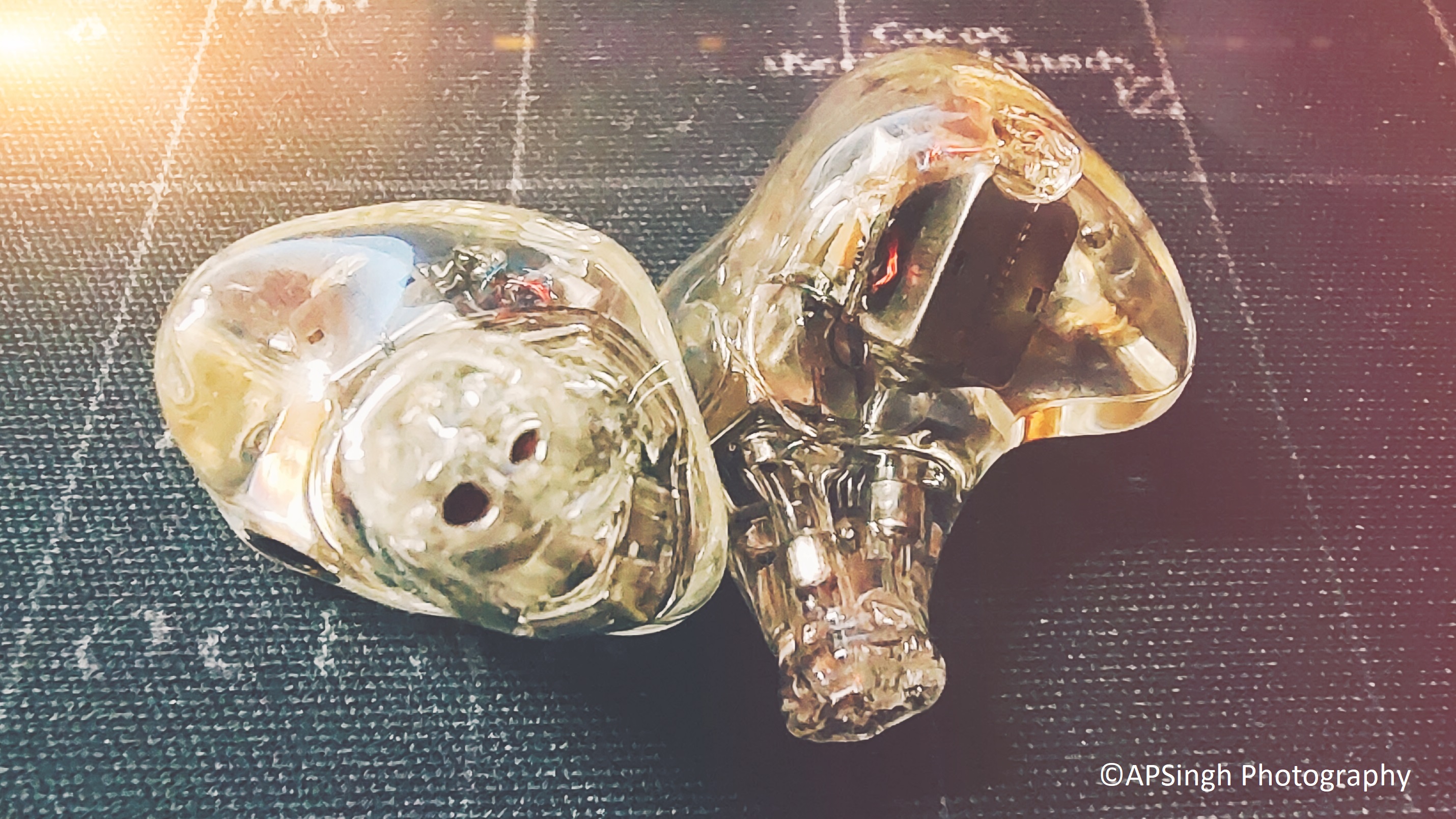
Soundstage:
The only shortcoming so far, I have seen is soundstage which one looks in an IEM of this price range. The soundstage felt lack of width whereas it is only above average in terms of verticality. The depth is also average. But to me it is not much of a deal breaker because of the other aspects it offers.
Tested tracks like “Hello” by Neelix , “Dream Catcher” by Bassnectar, and on all of them the verticality and depth was average and soundstage felt very much congested but the IEM did shine out on other parameters like detailing, imaging and presentation of bass and treble and overall experience despite of lack of soundstage felt very much engaging.
Detailing/Imaging:
BGVP has done a marvelous job in placement and tuning of DM8, it offers brilliant micro details. To me the best part of DM8 is the way it brings out all the technicalities. Although, in some tracks the micro details do become overwhelming sometimes but overall sound output of DM8 is very enjoyable.
It was a nice experience I must say while listening to “Reaching Out by Bassnectar” and “Draft Punk’s Giorgio by Moroder” with great bass response along with the micro detailing and the dynamics.
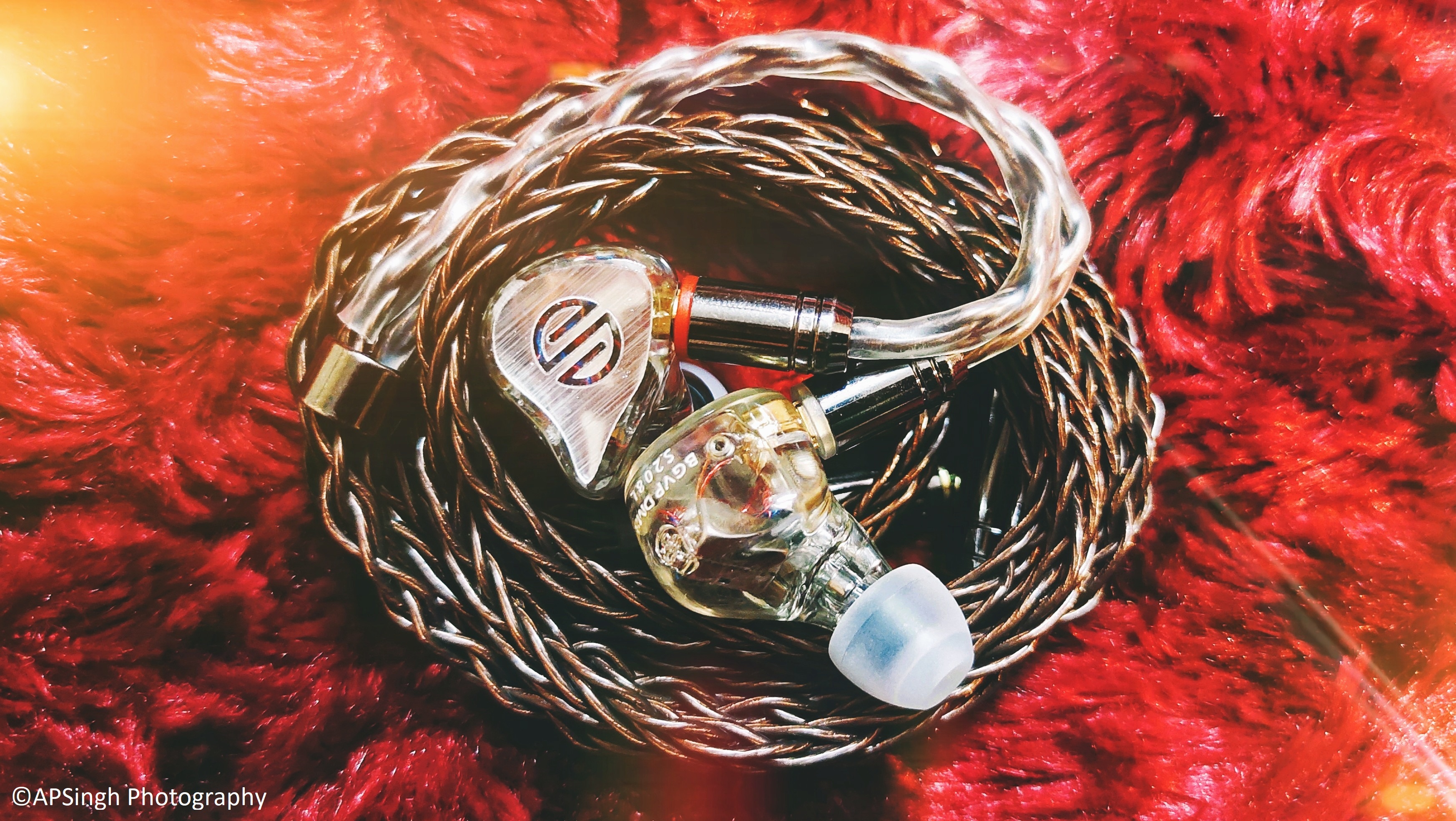
Final Verdict:
As BGVP says in their tagline that 'Music is the monologue of Soul', DM8 does a near perfect job of connecting you to your soul through music. It is a very well-tuned all BA packed beast that brings out ultra-micro-detailing with a very good timber throughout spectrum with a slight warm presentation. The Bass response it very good for a BA setup and overall signature is towards warm side. This is a gem of an IEM in mid-fi range I must say with a pack full of accessories of practical use.
DM8 is the latest flagship IEM by BGVP, a Chinese company mainly involved with customizing and producing high end Hifi earbuds, earphones and other electronic products.
DM8 spreads its charm right from its unboxing. It comes packed in a beautiful double box. The outer box has shiny surface with DM8 written over a colorful background along with other information about the IEM.
The inside box is of matte black finish with all in-box items meticulously placed.
In the box you would find a set of 10 ear-tips, an 8 stranded braided copper colored stock cable, a round
black box to keep the earphones safe and finally the earpieces. The box also has a cleaning brush, a 4.4mm balanced and a 3.5mm single-ended connector set along with a small white envelop that carries warranty card, manual and other essential documents.
The main connector of the wire is a rich looking chunky metallic cylinder with similar texture as that of end plug barrels and Y-split piece.
The IEM are available in 3 color variation- Blue-Pink, Woodcarving and transparent, I have received a transparent unit with a silver face-plate with BGVP logo printed on one and DM8 printed on the other as a part of review circle.
The Earpieces are bulky, 3D printed resin unit with a short nozzle. They are handcrafted, fully transparent body giving a glimpse of the technology they encapsulate. There is a tiny air-ventilation hole beneath the units.
All in-box items are premium looking and gets one excited as one opens it.

Package Contents:
• One pair of BGVP DM8 IEMs.
• One UPOCC 6N 8-strand single crystal copper 24awg MMCX cable with 2.5mm termination.
• 2.5mm to 3.5mm adapter.
• 2.5mm to 4.4mm adapter.
• One pair of Memory Foam ear tips.
• Nine pairs of silicone ear tips (3 pairs vocal, 3 pairs balanced, 3 pairs bass ear tips).
• Hard carry case.
Disclaimer:
I have received BGVP DM-8 as part of review circle sent from the brand itself in exchange of honest reviews. All impressions of sound are subjective to my own listening and my sources and is based on my experience with IEMs of similar hardware configurations and price range. You can read my other reviews on head-fi or my personal blog.

Sources:
For this review the unit has been paired to A&K SE100 (ES9038 Pro) and Fiio Q5 (AK4490), mostly using the balanced out without any other amplification.

Highs:
Listening to the “Shape of My Heart by Sting” was the first experience I had on it, and it immediately made me fell in love with DM8, The way it filled complete headroom with all the airiness and microdetails was something heart touching.
DM8 has the perfect sparkling highs which one notices straight out of the box. There is no sibilance or harsh tones at any point of time. Treble response is well extended, and airiness is all around the headroom with crisp details and overall gives a balanced tuning at this spectrum range.
Mids:
The mid spectrum reproduction is very uniform and is one of the best tuned IEMs. The vocal presentation is amazing and natural. There is uniformity throughput the mids section, be it the lower mids or the upper mid-range spectrum. There is no bass bleed into mids and thus the detailing and timber is amazing. There is a feel of airiness and presence factor specially when listening to guitars, cymbals and trumpets.
I felt bit inclination towards warm tonality, the male vocals sound perfect while female vocals are sharp and overall results are crisp and upfront notes which fill the entire headroom and best example of this was felt while listening to “A million Dreams” cover by Peter Hollens.
Or be it the original “Beauty and the Best” soundtrack by Celine Dion, Peabo Bryson it literally connects one to the soul I must say. Not to forget my initial experience with “Shape of My Heart by Sting”.
Lows:
DM8 has an amazing bass response for a full BA architecture, the Bass response is punchy and has a nice slam to it. It is full bodied and have a nice texture. Even sub-bass region is not shy at all and easily reminds of any dynamic driver. The Bass is the third best thing about DM8 after micro-detailing and mids.
I enjoyed listening to my favorite bass-oriented track - “Tokyo Drift” by KVSH, the bass was tight and precise. I must say DM8 can bring any IEM with typical dynamic driver to shame by its bass response. A job well done in implementation of BA drivers. Kudos BGVP for this!!

Soundstage:
The only shortcoming so far, I have seen is soundstage which one looks in an IEM of this price range. The soundstage felt lack of width whereas it is only above average in terms of verticality. The depth is also average. But to me it is not much of a deal breaker because of the other aspects it offers.
Tested tracks like “Hello” by Neelix , “Dream Catcher” by Bassnectar, and on all of them the verticality and depth was average and soundstage felt very much congested but the IEM did shine out on other parameters like detailing, imaging and presentation of bass and treble and overall experience despite of lack of soundstage felt very much engaging.
Detailing/Imaging:
BGVP has done a marvelous job in placement and tuning of DM8, it offers brilliant micro details. To me the best part of DM8 is the way it brings out all the technicalities. Although, in some tracks the micro details do become overwhelming sometimes but overall sound output of DM8 is very enjoyable.
It was a nice experience I must say while listening to “Reaching Out by Bassnectar” and “Draft Punk’s Giorgio by Moroder” with great bass response along with the micro detailing and the dynamics.

Final Verdict:
As BGVP says in their tagline that 'Music is the monologue of Soul', DM8 does a near perfect job of connecting you to your soul through music. It is a very well-tuned all BA packed beast that brings out ultra-micro-detailing with a very good timber throughout spectrum with a slight warm presentation. The Bass response it very good for a BA setup and overall signature is towards warm side. This is a gem of an IEM in mid-fi range I must say with a pack full of accessories of practical use.
Last edited:
D'Ford'Guy
New Head-Fier
Pros: * Balanced Tuning
* Good Technical Ability
* Superbly done bass for a BA implementation
* Coherency in the midrange
* Dynamic Range and Imaging is outstanding
* Good Technical Ability
* Superbly done bass for a BA implementation
* Coherency in the midrange
* Dynamic Range and Imaging is outstanding
Cons: * Treble extension and energy needs work
* Fit is so-so (YMMV)
* Build quality and finishing of the shells can be done much better
* Does the cable have to be this hefty and weighty?
* Fit is so-so (YMMV)
* Build quality and finishing of the shells can be done much better
* Does the cable have to be this hefty and weighty?

Disclaimer:
The BGVP DM8 is a sample that was sent to me in exchange for my honest opinion in this review, as part of a review tour. I thank the team at BGVP for giving me this opportunity.
Introduction:
BGVP the brand needs no introduction as it has made its mark for having stomped onto the playing field with products that have been the talk of the town at the time of release, since inception (even if they weren’t necessarily worth all that attention). However, over time, the company has transformed its quirky offerings to a more matured and established line-up. The DM8 is question here is the follow up to the DM7 which originally kicked off with the DM6 and aims to set the bar much higher than before. It better be setting that bar high in terms of sonic abilities, as the asking price of subsequent upgrades to the DM8 from the original DM6 has almost doubled in 2021.
For those who find it interesting as what the 16 drivers inside are and what do they do, here’s a little driver tour for you:
The DM8 gets a four-way crossover, with an array of drivers divided into each of those crossovers, covering the upper treble, upper mid / lower treble, midrange and bass frequencies. The bass frequencies are handled by a dual chamber BA driver - Sonion 38D1XJ007, Midrange is a duet performance by the Sonion 2354 and Knowles RAF-32873, Upper mids / Lower treble is taken care by the Knowles dual-chamber TWFK-30017 and the upper treble and ‘inaudible high resolution territory’ is handled by the dual-chamber Knowles SWFR-3173.
Tested At:
349$ at the time of writing this review
Test Rig:
Marantz SR5014, LG G8X ThinQ & VE Odyssey Dongle DAC
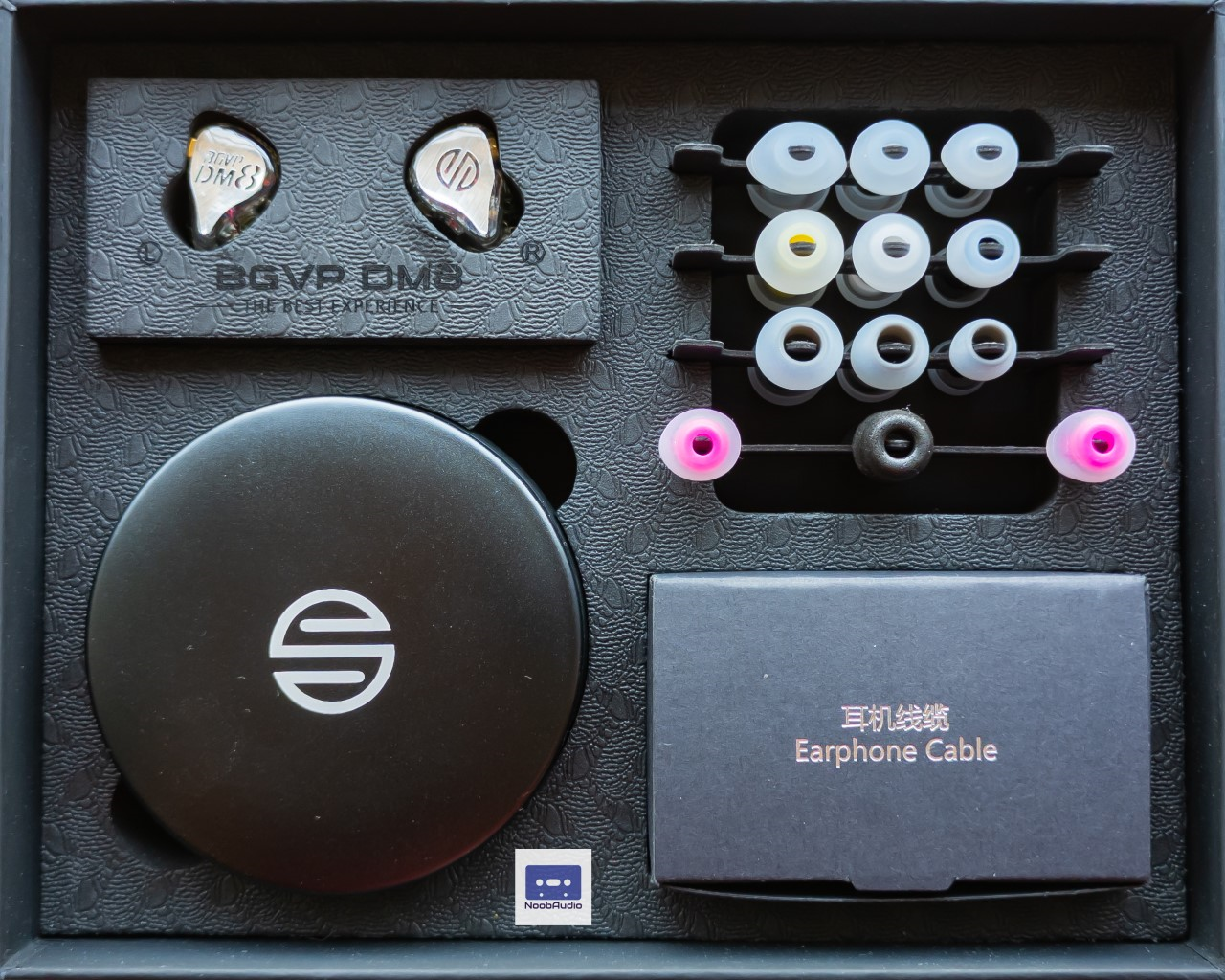
Tonality & Presentation:
Let’s start with what seems to be very commendable in 2021 and that too from a ChiFi manufacturer is that, the DM8 is not following the herd and hence isn’t your typical – details shoved up the face – harman tuned signature. Thankfully someone still believes that an iem should also be enjoyable sometimes to listen to and that people listen to them to also sit and enjoy a lazy, peaceful Sunday afternoon! I wouldn’t call the DM8 your average V signature either. It has balance going for it overall, nothing in the midrange seems to feel overly forward or scooped and the extensions are decent to not crib about in any way.
Tonality can be classified as just ‘warm’ and well balanced with a bit of energy in the upper mids to keep the midrange energetic and alive. Coming from the DM6 which had a knack of being one of the most finicky of iem’s with respect to source pairing, QC issues w.r.t. tuning and cable matching, and the DM7 being basically a DM6 on steroids with a more intense presentation (for all the wrong reasons), the DM8 is a step in the right direction by BGVP as not only is the DM8 a proper upgrade from its predecessors, there is significant maturity from a tuning and resolution standpoint.
Sonic Performance:
DM8’s sonic ability is testimony to the fact that a handful of Chifi OE’s are listening to what the consumer actually wants. I can imagine that a lot of people who listen to the DM8 would say that BGVP has played the ‘safe card’ here, swaying away from the typical V or upper mid focussed signature. But hey, music recorded, mastered or mixed in studios were not produced to be played back as shouty or scooped up pieces which we dub as ‘natural’ eventually, coz most people (specially new in this hobby) mistake intense and shouty signatures to be ‘highly detailed’ and ‘high resolution’, which is not necessarily the case. One way of masking poor tuning and low-resolution output from the transducers is to either boost and bloat the lower frequencies, or to significantly spike the upper mids and treble. While the latter can yield good results as well, it generally comes at the cost of timbre accuracy and a fatiguing listen.
Thankfully, it’s none of that on the DM8!
Bass – The bass here is very dynamic driver like for a BA only set, and its not shoved up your face either with subpar decay and bleed. On the contrary, there is a subtle and calm demeanor to the bass notes of the DM8 such that they can be soft, yet impactful and really give it the beans when called for. The bass isn’t aggressive, although it does try and show its prominence in the slightest hint of bass on a track. Mid bass and upper bass are very well controlled with tight body and dynamics, but picky ears will be able to distinguish the bass to have a few BA traits such as not having the perfect natural decay that a dynamic driver produces. Sub bass although done very well and extends deep, does have significant roll off below 30 Hz,
Midrange – Mids sound natural which is key for an all BA set specially at this price point. Lower mids are clean and slightly dipped but thanks to the seamless bass to mids transition, there is no mid bass bleed and hence keep the lower mids from getting masked even on complex tracks. Upper mids have a very effortless rise with just the right amount of energy to be called energetic, but not so much as to be called fatiguing or spiky or intense. I haven’t been able to get it to misbehave even on poorly mastered tracks. Inspite of this ‘safe tuning’, midrange vocal texture and details are done well. Thanks to the balanced tuning, timbre is realistic and sounds natural for the ‘most part’. Yeah ‘most part’ coz some parts of the treble tuning and its harmonics do tend to affect vocals on some tracks to have a slight nasally tone. Its rare and not so much of a concern and doesn’t alter the overall tonality so much, but in rare occasions, you do hear this trait.
Treble – This is one place where the DM8 doesn’t seem to push the boundaries. Treble energy is about ‘enough’ such that the overall presentation doesn’t sound muted and sucked out, but a little more boost in the upper registries can positively push the perception of a bigger and airier soundstage. This department alone perhaps pulls the DM8 in sounding like a midfi set and it’s a bit of a surprise considering there is a dedicated driver specifically for the uppermost frequencies. Perhaps they are sending out a secret message to the high-resolution bats sitting at 40kHz! (No kidding)
Soundstage, Instrument Separation & Imaging:
Soundstage is realistic, and about average. There isn’t something special that the DM8 does to fool you into believing that you maybe listening to full size headphones or the fact that you aren’t listening to 2 pieces of candies stuck to either sides of your head that’s making some noise. That said, there’s a good sense of depth and height on display, just that the overall experience isn’t holographic or all that out-of-your head like say on something like the Sony EX1000 or the Sennheiser IE800 or the Campfire Audio Andromeda of yore. This is another attribute which makes the DM8 a typical midfi contender.
Instrument separation is excellent and there is no smearing or haziness on even the most complex tracks. Layering and dynamic range is truly pushing the boundaries of this price category and is amongst the very best.
Imaging is again pin-point and much better than the average iem in this price category specially because of how well the DM8 does its centre image. It can project right in front and at some distance which is the biggest challenge on most midfi iems and the DM8 does it without breaking a sweat.

Comparisons:
Will purely stick to sonic differences here for the sake of being objective
BGVP DM8 vs Tin Hifi P2
The only thing common between these 2 iems is the fact they fall in similar price brackets! DM8 is a 16 BA driver monster whereas the P2 is a bigger anomaly being a closed back Planar iem. Both have completely different presentations and quirks. Since there is a whole new review coming up for the Tin Hifi P2, I will not elaborate too much in this comparison other than the obvious bottom-line. The DM8 is the more reference listening experience focussing on details and accuracy and being very clean while doing all that. The P2 is warm and musical, has softer transients and that planar bass and midrange presentation that planars are famous for. Listening to both iems back to back makes the DM8 sound like a muted iem only because the P2 has so much upper treble, it puts my own Sennheiser IE800 to shame which already is known for its shimmery (sometimes splashy) treble. Where the DM8 is a very comfortable and safe tuning, and can be enjoyed off your everyday phone, the P2 can be fatiguing depending on one’s tolerance to upper treble, and it takes the earths rotation to be powered up. Duh!
BGVP DM8 vs Fearless S6 rui
Its been a while, almost 2 years since the S6 rui hit the market, and ironically so, is still relevant enough even today to find a comparison spot against the DM8. The S6 rui is down on the outright number of drivers, but that barely seems to keep it from performing like an absolute star. The S6 rui is a V signature of sorts but the midrange seems to be lush and quite hefty such that it portrays a lot more note weight compared to the flatter and leaner notes of the DM8. Instrument separation is on par on both the iems, with the DM8 edging the S6 rui on being slightly quicker on transient responses, but the S6 rui pulls right back with its midrange texture and expanse. The DM8 is perfectly scaled on the upper mids whereas the S6 rui can be a bit too forward at the 4kHz point which may seem intense to some. Bass performance on the DM8 is tight but soft and a bit forward with not much coloration, whereas the bass on the S6 rui is more bloomy and warmer which adds to the overall tonality and heft to the lower midrange as well. However, the S6 rui sounds more holographic and more of an experience than the more reference like sounding DM8 which always feels flatter so picking one over the other is a matter of tolerance to each tuning preference. If one had to summarize the differences, the DM8 is the technical champ but is lacking the emotion and soul of the S6 rui which seems to find ways to indulge you deeper into your music.
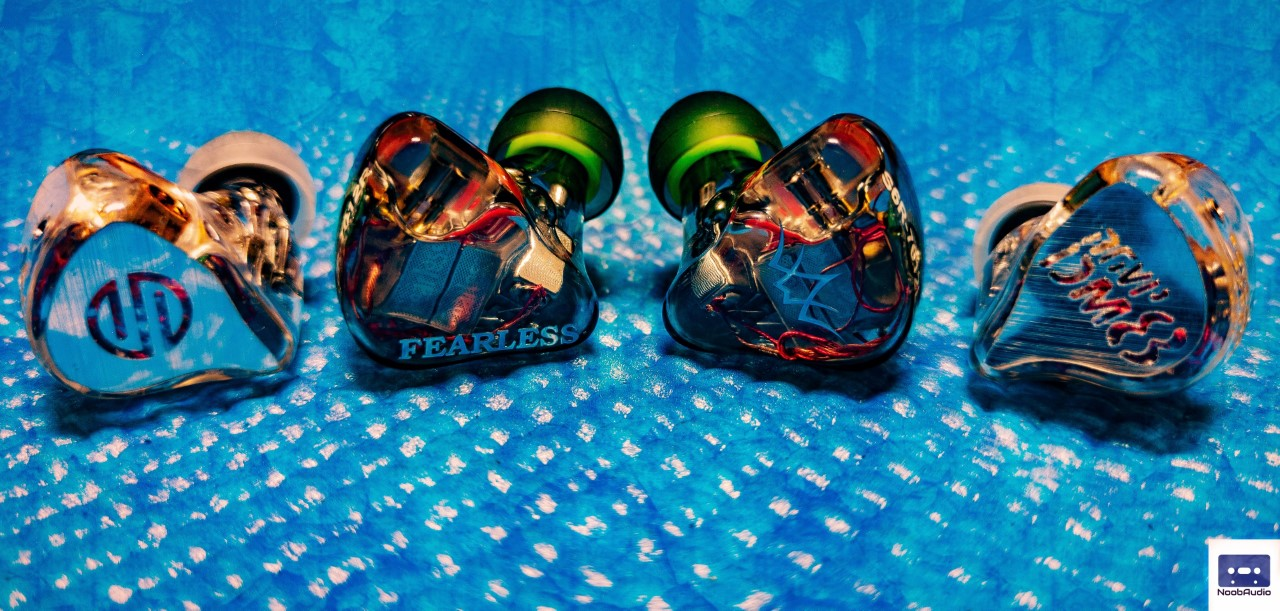
Summary:
Finally, for the first time since the inception of BGVP, there is a product in the DM8 that can be wholeheartedly be recommended to the masses not only as a VFM proposition but also as a package that isn’t too finicky, nor does it warrant outrageous source matching or rampant cable and eartip swaps! Its not the best iem money can buy, nor is it an Andromeda (sorry DM6 fanboy’s, you still have to wait it out a bit). You do have a few alternatives to the DM8 like the Fearless S6 rui which is on par in terms of performance, but the S6 rui is an acquired taste and more of an ‘audiophile’ tuning whereas the DM8 is a tuning that is bound to please everyone and still wow the audiophiles at the same time. If the fit and comfort is something that’s inline with your requirements, I think the DM8 is well worth the time and money.
Last edited:
Leonne
compare to Blessing 2 pls?
gadgetgod
1000+ Head-Fier
Pros: BA bass done amazingly well.
Outstanding build quality and excellent packaging too.
High-quality balanced cable.
Aggressive yet sound signature.
Outstanding build quality and excellent packaging too.
High-quality balanced cable.
Aggressive yet sound signature.
Cons: Personal preference only, I found the DM7's excessive aggressiveness better but that's just me.
BGVP has produced some amazing in-ear monitors in their all BA “DM” series. While I am not a fan of the highly appreciated DM6 as I found it too piercing and sharp, I love my pair of DM7 that was gifted to me by a fellow audiophile friend. It is actually my favorite pair after I sold the Solaris in need of some funds. Last month around BGVP announced their latest flagship pair from the “DM” series, the all-new BGVP DM8.

The BGVP DM8 is the latest flagship multi-BA driver IEM from the brand featuring eight Knowles BA drivers on each side. They have used 5 Knowles BA drivers and 3 Sonion BA drivers in a four-way frequency division. The pair has a price tag of 349$, but is it worth the 350$ price tag??? We will surely find that out in this review!!
Disclaimer:-
BGVP themselves organized a review tour for this flagship IEM in my country through one of my friends, and I got the opportunity to audition these for this review. I am in no way affiliated or paid by anyone to write positive or negative about the DM8. All the thoughts and impressions in this blog are completely my own based on my own time with the pair over the past week.
I hope you enjoy reading my blog, if you do find it interesting do follow on my Facebook page here. You can buy the DM8 from HiFiGo for 349$ from here. I am not getting any affiliation benefit with HiFiGo for this link.
Unboxing:-
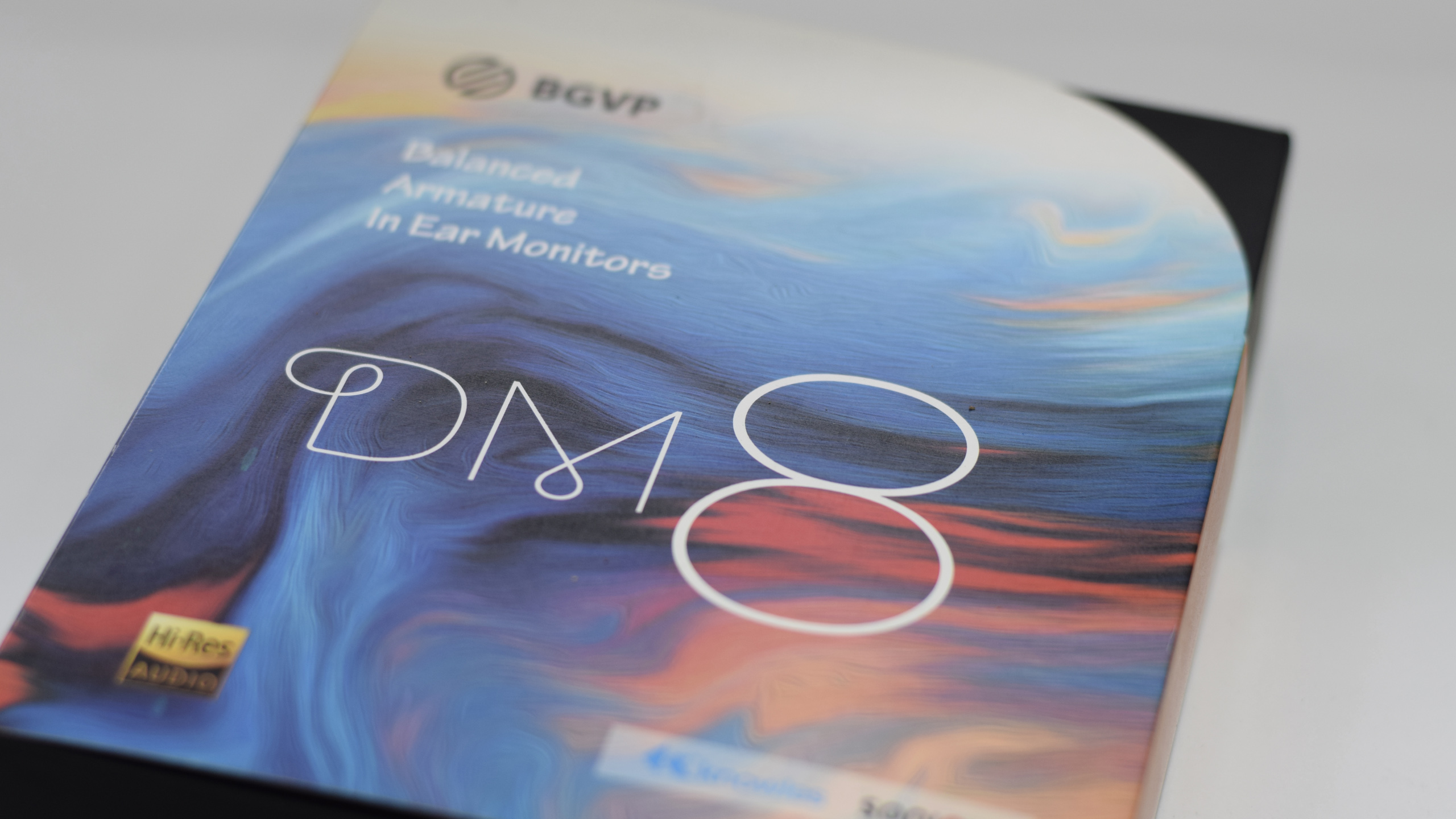
Earlier BGVP IEM’s used to have a very simple packaging, this time things have taken a colorful turn with the DM8. The outer packaging is quite colorful and is actually a bit bigger than the previous models like the DM6 and DM7. Inside the packaging, the arrangement looks delightful. It has so neat placement of the contents that it simply looks beautiful and eye-catchy.
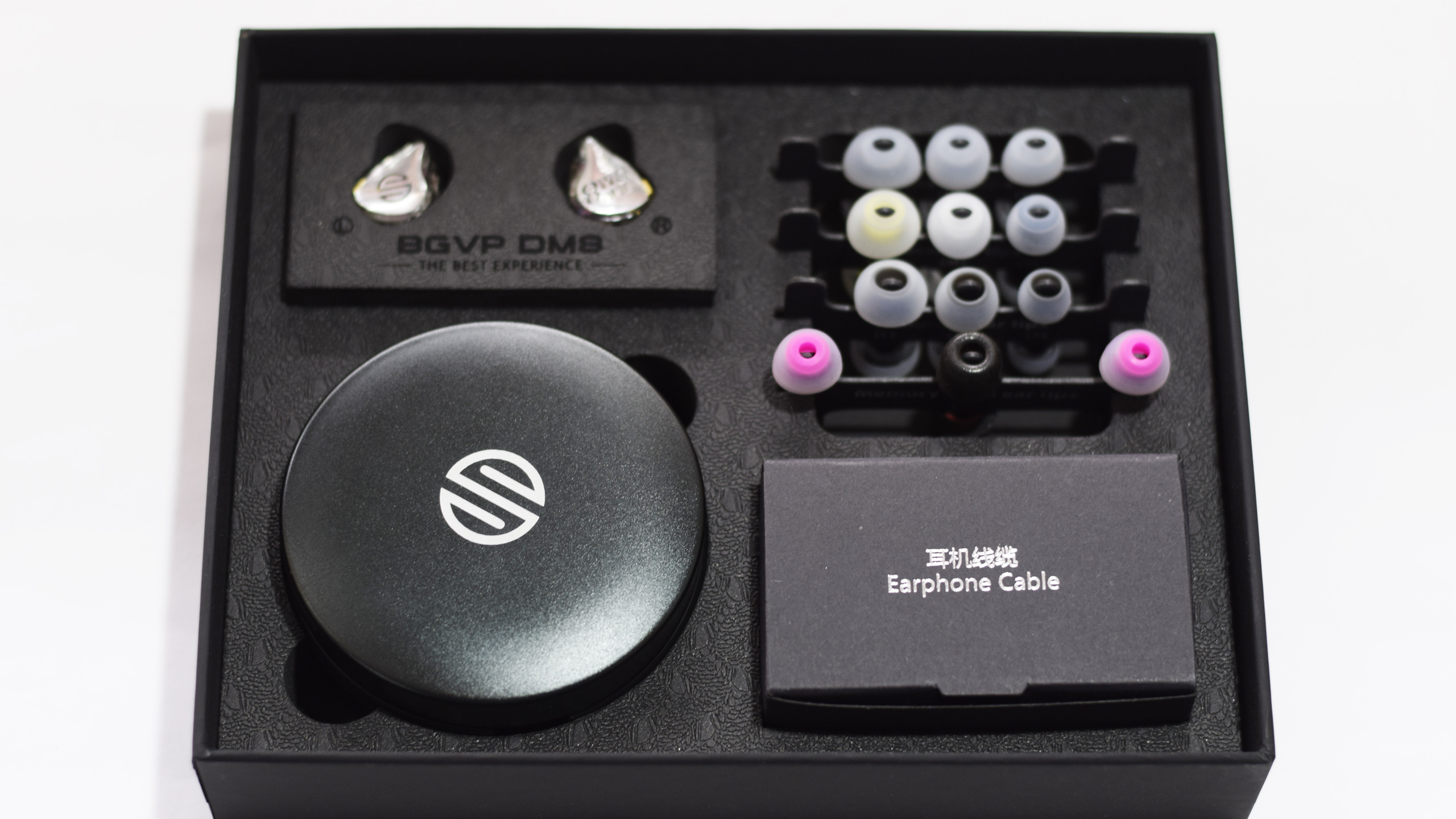
On the top, we have our very beautiful DM8 earpieces sitting firmly into their branded foam cutout. The ear tips are presented in a very beautiful manner. They are arranged on hard cardboard stick type designer panels. There’s a plain cardboard case with earphone cable printed on top of it, as the print suggests, it holds our cable. The metallic carry case holds the 4.4mm and 3.5mm adapters as the included cable has a balanced 2.5mm termination. Overall the packaging arrangement is quite neat and looks superb. I just loved how BGVP has designed the packaging for the DM8.
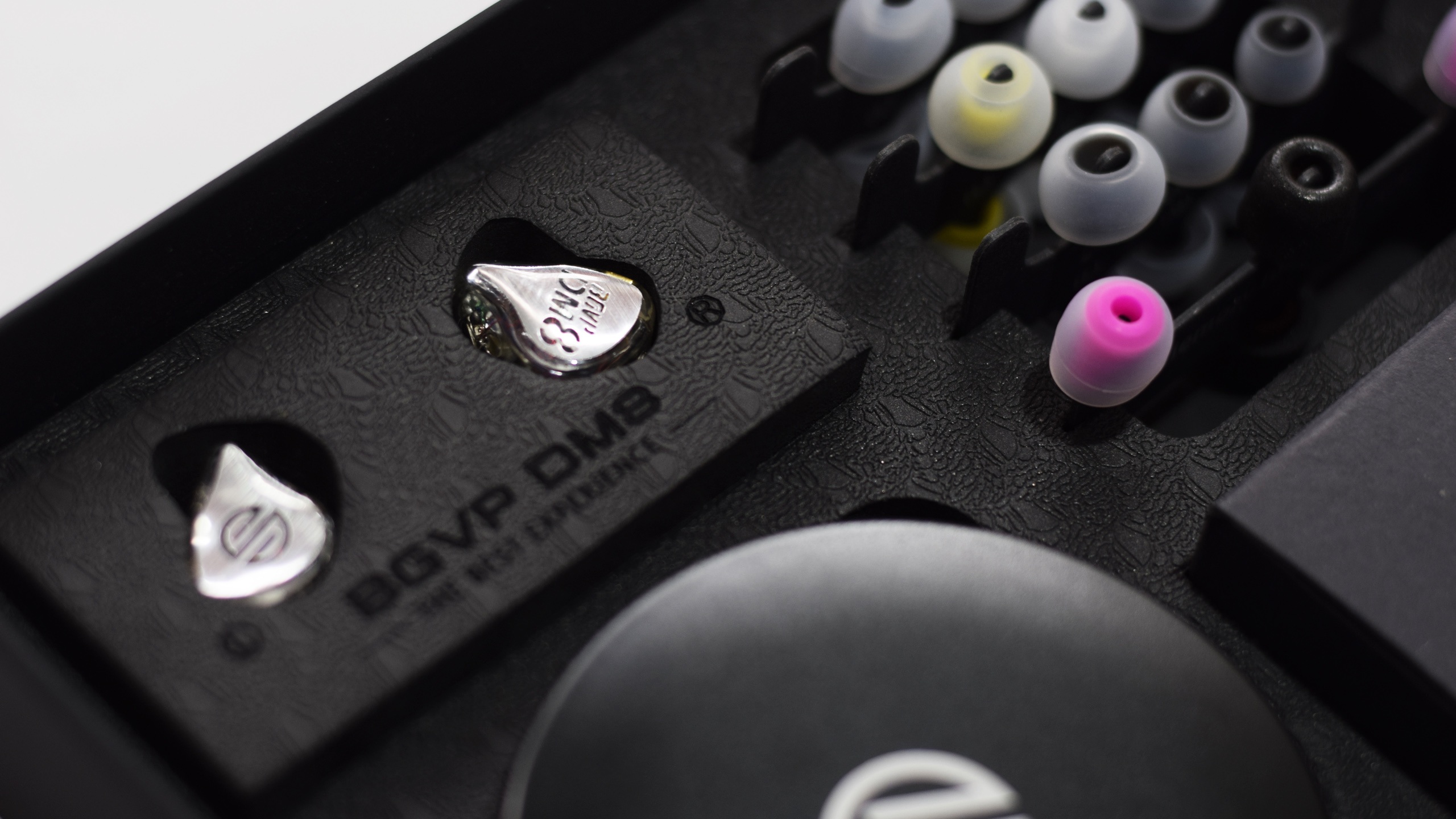
Package Contents:-
>One pair of BGVP DM8 IEMs.
>One MMCX cable with 2.5mm termination.
>2.5mm to 3.5mm adapter.
>2.5mm to 4.4mm adapter.
>One pair of Memory Foam ear tips.
>Nine pairs of silicone ear tips(3 pairs vocal, 3 pairs balanced, 3 pairs bass ear tips).
>Metallic carry case.
Build Quality & Fit:-
I got the transparent variant of the DM8 for review. The ear shells look very beautiful with silver shiny face panels. The left earpiece has BGVP DM8 branding and the right one has BGVP logo branding on the faceplates.




The ear nozzle is quite short though there are no issues in fit thanks to the ergonomic design with the pair. One can easily see the professional internal placement of drivers through the transparent inner cavities. It’s actually quite amazing to see how professionally BGVP has placed the eight drivers, acoustic tubes, and the audio motherboard for these many drivers inside such small earpieces. We also have a vent on the side of the earpieces. As for connectors, the DM8 features MMCX connectors on top of both the earpieces. Honestly speaking, the pair has a robust build quality and looks absolutely fantastic.

The included cable is thick and heavy. It has shielded corners near the connectors for an easy over the ear fit.
In terms of fitting, the DM8 fits like a charm. The cable might be heavy, but the earpieces are lightweight and have an ergonomic design. They sit very firmly inside the ears and provide a super comfy fit for long music sessions.
Driving the BGVP DM8:-
The BGVP DM8 is a very easy to drive pair. It has an impedance rating of 27 Ohms with 110dB/mW high sensitivity. I used the pair with my iBasso DX120 and Topping E30+L30 combo. Both the combos were nice but here are my impressions of both of them.
DM8 with E30+L30:-

I am in love with this stack ever since I got it. And now when paired to the DM8 it sounds like Audio Nirvana!!! Even though the pair doesn’t require this much power, I had to use it at the low gain(-9dB), The pair sounds fantastic with a super clean background and deep punchy bass. I love how minutest of the details pop out on a pitch dark background with this combo.
DM8 with DX120:-
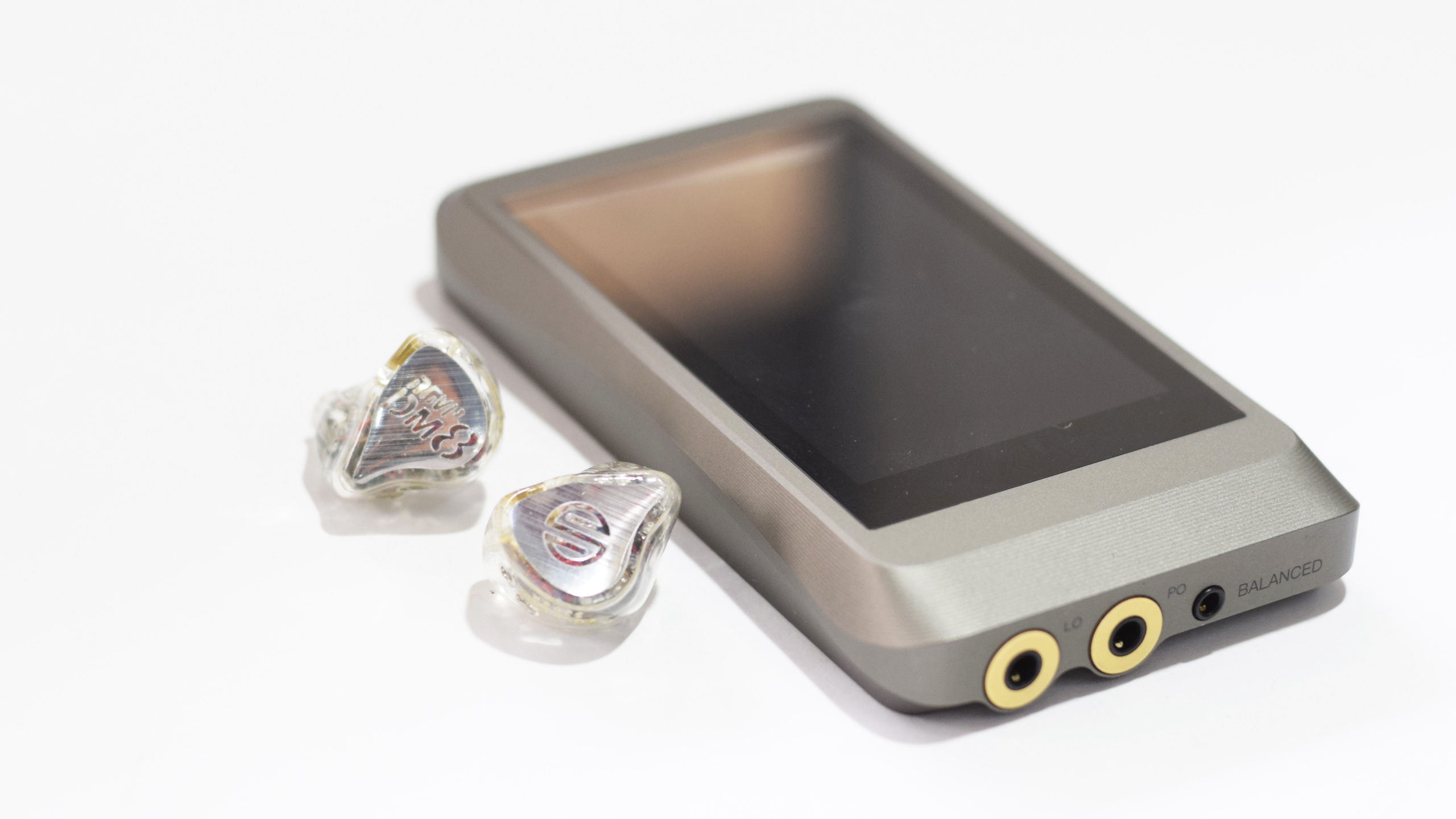
The pair shows beautiful lush details. The bass slams are precise and perfect though they lack a little bit of extension when compared head to head with the Topping E30+L30 combo. But if you ask me portably I found this stack to be a great one too.
Sound Quality:-
I love how BGVP is progressing things with their DM series now. My first IEM from the series was the DM6 which I just couldn’t cope with for its super-sharp treble response, with the DM7 it was improved with no harshness at all. It sounded aggressive but not harsh. With the DM8 it is improved even further with a smooth, detailed response. There is still a little bit of aggressiveness but I guess that is due to the BGVP’s upfront sound representation.
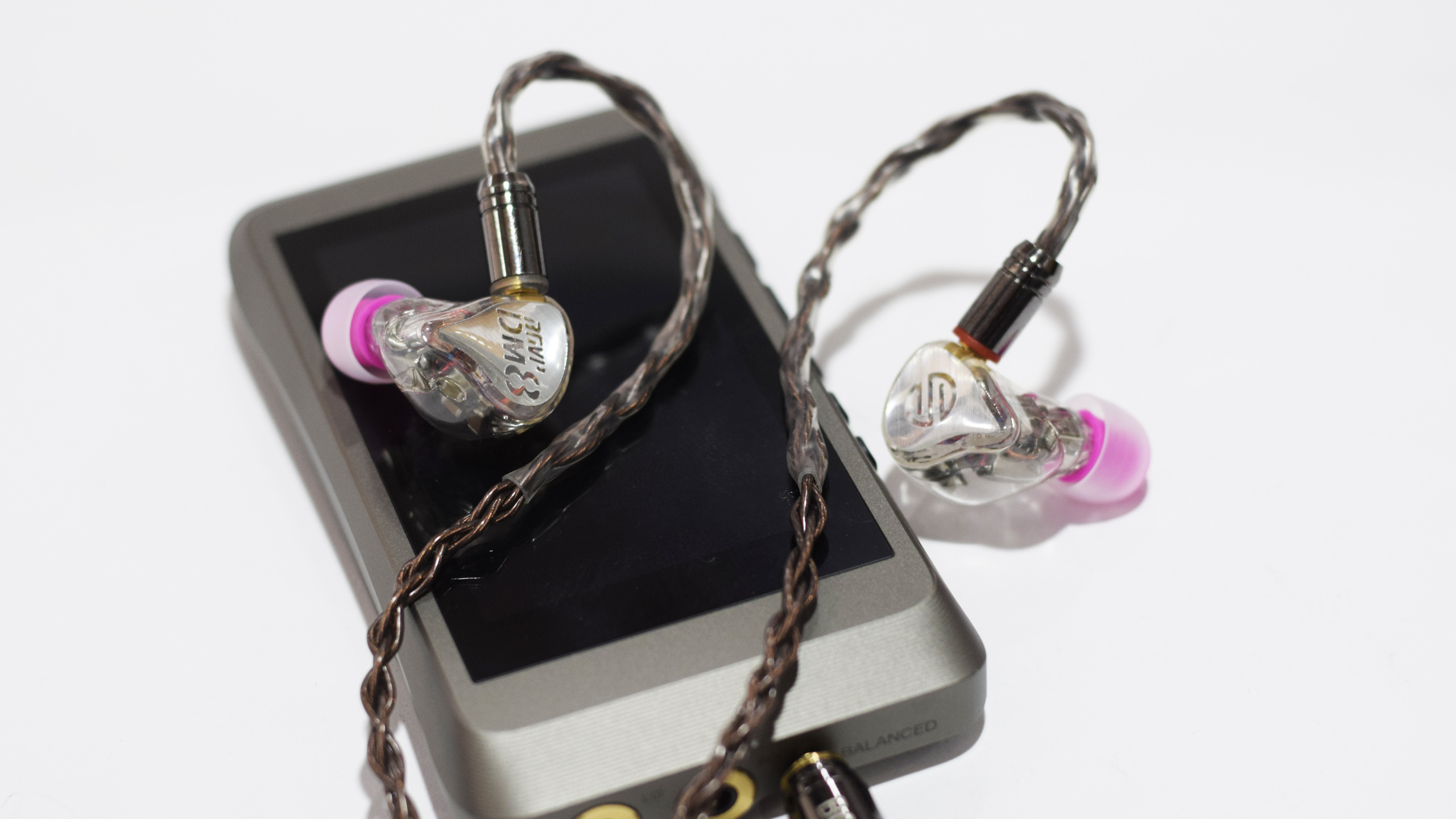
Another thing to complement here is the rich Bass presentation. Multi-BA IEM’s that I have tried before like the QOA Mojito(6BA), Audiosense DT200(2BA) have a slow bass response, but with the DM8, the bass presentation is simply amazing providing the user with deep punchy bass and a fantastic sub-bass rumble. Now let’s describe how the DM8 sounds according to different frequency response.
Lows:-
As stated above, the DM8 bass is fantastic. In fact, it doesn’t feel like a BA producing the bass, the sound is quite similar to DD. The bass slams have a rich, fine texture to them with a quick, punchy response to complement your music. The best part is the bass is controlled well within its region, there is no overlapping or unnecessary muddiness in the output even in heavy bass tracks like La La La by Y2K.
Mids:-
The mid frequencies seem to be the center point of attraction in the output to me with an upfront representation. When I got the DM8 I also had the Tin HiFi P2 for review and I personally found the mid frequencies to be more upfront in DM8 as compared to the P2. The detail retrieval and vocal presentation are simply perfect, listening to an acoustic-vocal song like First Time by Macy Gray is a fantastic experience with the DM8. I just simply loved the vocal clarity!!! There is ample airiness in this segment to provide a spacious stage feel in the output.
Highs:-
BGVP DM8 has a slight bit of sparkle and energy in the treble portion. This is though nothing when compared to the DM7 that makes the DM7 much more aggressive. I guess BGVP has done this to make the DM8 smoother and relaxing. Detail retrieval is still good and presents the user with a non-fatiguing signature. There is no sibilance or harshness even at louder volumes. If you listen to complex tracks like God Of War Theme By Tina Guo, you will find the instrument detailing and layering to be detailed really well. Though as a personal preference, I prefer the extra aggressiveness of the DM7.
Soundstage and Imaging:-
The BGVP DM8 has a wide soundstage representation. Eyes closed while listening to your favorite music, you will find yourself in a wide space with ample tallness and depth. Imaging and detail retrieval is simply perfect.
Now some comparison time!!!
BGVP DM8 Vs BGVP DM7:-

In my experience with both of them, BGVP seems to have tamed down the high frequencies in the DM8. The DM8 sounds more relaxed while the DM7 sounds more aggressive. I personally found the detailing to be a bit better in DM7 but the extra aggressiveness can sound fatiguing to some people during long listening sessions.
For long listening sessions, the DM8 is a better choice with a relaxed response.
I found the bass extension in DM8 to be better with a cleaner, well-textured response. All in all, I like the DM7 for a more fun signature and the DM8 for a relaxed signature.
BGVP DM8 Vs Tin HiFi P2:-

The BGVP DM8 can be powered easily even with entry-level hi-res players while the Tin HiFi P2 needs a truckload of power. For bringing out the true potential of P2 one has to pair the IEMs with a desktop-grade powerful amplifier.
For smooth frequency response, the DM8 excels as it has a relaxed signature while the P2 has a bit of sparkle in the treble portion.
I love the planar bass that the P2 delivers when powered properly. There is nothing as clean as a properly implemented planar driver bass. P2 also produces powerful rumble in the Sub-bass region.
The BGVP DM8 has more upfront vocals when compared to P2.
Between these two everything comes down to your source, the P2 can't be powered easily while the DM8 can be powered super easily using hi-res players or even smartphones.
Final Verdict:-

BGVP has done a fantastic job with the latest DM8. The bass response here feels nowhere near a BA bass, it can easily compete with the fast and quick bass response from a Dynamic driver. Is it worth its 349$ price tag??YESSSSSS, I would easily recommend this for its easy drivability, detailed, relaxed sound signature, and beautiful looks!!! But when it comes to my personal preferences, I like the excessive aggressiveness of the DM7.

The BGVP DM8 is the latest flagship multi-BA driver IEM from the brand featuring eight Knowles BA drivers on each side. They have used 5 Knowles BA drivers and 3 Sonion BA drivers in a four-way frequency division. The pair has a price tag of 349$, but is it worth the 350$ price tag??? We will surely find that out in this review!!
Disclaimer:-
BGVP themselves organized a review tour for this flagship IEM in my country through one of my friends, and I got the opportunity to audition these for this review. I am in no way affiliated or paid by anyone to write positive or negative about the DM8. All the thoughts and impressions in this blog are completely my own based on my own time with the pair over the past week.
I hope you enjoy reading my blog, if you do find it interesting do follow on my Facebook page here. You can buy the DM8 from HiFiGo for 349$ from here. I am not getting any affiliation benefit with HiFiGo for this link.
Unboxing:-

Earlier BGVP IEM’s used to have a very simple packaging, this time things have taken a colorful turn with the DM8. The outer packaging is quite colorful and is actually a bit bigger than the previous models like the DM6 and DM7. Inside the packaging, the arrangement looks delightful. It has so neat placement of the contents that it simply looks beautiful and eye-catchy.

On the top, we have our very beautiful DM8 earpieces sitting firmly into their branded foam cutout. The ear tips are presented in a very beautiful manner. They are arranged on hard cardboard stick type designer panels. There’s a plain cardboard case with earphone cable printed on top of it, as the print suggests, it holds our cable. The metallic carry case holds the 4.4mm and 3.5mm adapters as the included cable has a balanced 2.5mm termination. Overall the packaging arrangement is quite neat and looks superb. I just loved how BGVP has designed the packaging for the DM8.

Package Contents:-
>One pair of BGVP DM8 IEMs.
>One MMCX cable with 2.5mm termination.
>2.5mm to 3.5mm adapter.
>2.5mm to 4.4mm adapter.
>One pair of Memory Foam ear tips.
>Nine pairs of silicone ear tips(3 pairs vocal, 3 pairs balanced, 3 pairs bass ear tips).
>Metallic carry case.
Build Quality & Fit:-
I got the transparent variant of the DM8 for review. The ear shells look very beautiful with silver shiny face panels. The left earpiece has BGVP DM8 branding and the right one has BGVP logo branding on the faceplates.




The ear nozzle is quite short though there are no issues in fit thanks to the ergonomic design with the pair. One can easily see the professional internal placement of drivers through the transparent inner cavities. It’s actually quite amazing to see how professionally BGVP has placed the eight drivers, acoustic tubes, and the audio motherboard for these many drivers inside such small earpieces. We also have a vent on the side of the earpieces. As for connectors, the DM8 features MMCX connectors on top of both the earpieces. Honestly speaking, the pair has a robust build quality and looks absolutely fantastic.

The included cable is thick and heavy. It has shielded corners near the connectors for an easy over the ear fit.
In terms of fitting, the DM8 fits like a charm. The cable might be heavy, but the earpieces are lightweight and have an ergonomic design. They sit very firmly inside the ears and provide a super comfy fit for long music sessions.
Driving the BGVP DM8:-
The BGVP DM8 is a very easy to drive pair. It has an impedance rating of 27 Ohms with 110dB/mW high sensitivity. I used the pair with my iBasso DX120 and Topping E30+L30 combo. Both the combos were nice but here are my impressions of both of them.
DM8 with E30+L30:-

I am in love with this stack ever since I got it. And now when paired to the DM8 it sounds like Audio Nirvana!!! Even though the pair doesn’t require this much power, I had to use it at the low gain(-9dB), The pair sounds fantastic with a super clean background and deep punchy bass. I love how minutest of the details pop out on a pitch dark background with this combo.
DM8 with DX120:-

The pair shows beautiful lush details. The bass slams are precise and perfect though they lack a little bit of extension when compared head to head with the Topping E30+L30 combo. But if you ask me portably I found this stack to be a great one too.
Sound Quality:-
I love how BGVP is progressing things with their DM series now. My first IEM from the series was the DM6 which I just couldn’t cope with for its super-sharp treble response, with the DM7 it was improved with no harshness at all. It sounded aggressive but not harsh. With the DM8 it is improved even further with a smooth, detailed response. There is still a little bit of aggressiveness but I guess that is due to the BGVP’s upfront sound representation.

Another thing to complement here is the rich Bass presentation. Multi-BA IEM’s that I have tried before like the QOA Mojito(6BA), Audiosense DT200(2BA) have a slow bass response, but with the DM8, the bass presentation is simply amazing providing the user with deep punchy bass and a fantastic sub-bass rumble. Now let’s describe how the DM8 sounds according to different frequency response.
Lows:-
As stated above, the DM8 bass is fantastic. In fact, it doesn’t feel like a BA producing the bass, the sound is quite similar to DD. The bass slams have a rich, fine texture to them with a quick, punchy response to complement your music. The best part is the bass is controlled well within its region, there is no overlapping or unnecessary muddiness in the output even in heavy bass tracks like La La La by Y2K.
Mids:-
The mid frequencies seem to be the center point of attraction in the output to me with an upfront representation. When I got the DM8 I also had the Tin HiFi P2 for review and I personally found the mid frequencies to be more upfront in DM8 as compared to the P2. The detail retrieval and vocal presentation are simply perfect, listening to an acoustic-vocal song like First Time by Macy Gray is a fantastic experience with the DM8. I just simply loved the vocal clarity!!! There is ample airiness in this segment to provide a spacious stage feel in the output.
Highs:-
BGVP DM8 has a slight bit of sparkle and energy in the treble portion. This is though nothing when compared to the DM7 that makes the DM7 much more aggressive. I guess BGVP has done this to make the DM8 smoother and relaxing. Detail retrieval is still good and presents the user with a non-fatiguing signature. There is no sibilance or harshness even at louder volumes. If you listen to complex tracks like God Of War Theme By Tina Guo, you will find the instrument detailing and layering to be detailed really well. Though as a personal preference, I prefer the extra aggressiveness of the DM7.
Soundstage and Imaging:-
The BGVP DM8 has a wide soundstage representation. Eyes closed while listening to your favorite music, you will find yourself in a wide space with ample tallness and depth. Imaging and detail retrieval is simply perfect.
Now some comparison time!!!
BGVP DM8 Vs BGVP DM7:-

In my experience with both of them, BGVP seems to have tamed down the high frequencies in the DM8. The DM8 sounds more relaxed while the DM7 sounds more aggressive. I personally found the detailing to be a bit better in DM7 but the extra aggressiveness can sound fatiguing to some people during long listening sessions.
For long listening sessions, the DM8 is a better choice with a relaxed response.
I found the bass extension in DM8 to be better with a cleaner, well-textured response. All in all, I like the DM7 for a more fun signature and the DM8 for a relaxed signature.
BGVP DM8 Vs Tin HiFi P2:-

The BGVP DM8 can be powered easily even with entry-level hi-res players while the Tin HiFi P2 needs a truckload of power. For bringing out the true potential of P2 one has to pair the IEMs with a desktop-grade powerful amplifier.
For smooth frequency response, the DM8 excels as it has a relaxed signature while the P2 has a bit of sparkle in the treble portion.
I love the planar bass that the P2 delivers when powered properly. There is nothing as clean as a properly implemented planar driver bass. P2 also produces powerful rumble in the Sub-bass region.
The BGVP DM8 has more upfront vocals when compared to P2.
Between these two everything comes down to your source, the P2 can't be powered easily while the DM8 can be powered super easily using hi-res players or even smartphones.
Final Verdict:-

BGVP has done a fantastic job with the latest DM8. The bass response here feels nowhere near a BA bass, it can easily compete with the fast and quick bass response from a Dynamic driver. Is it worth its 349$ price tag??YESSSSSS, I would easily recommend this for its easy drivability, detailed, relaxed sound signature, and beautiful looks!!! But when it comes to my personal preferences, I like the excessive aggressiveness of the DM7.
Attachments
machinegod
New Head-Fier
Pros: Class leading dynamics and imaging.
Unbelievable bass off a BA, better than most DDs.
Technically very capable.
Timbre on point for the most part.
Unbelievable bass off a BA, better than most DDs.
Technically very capable.
Timbre on point for the most part.
Cons: Upper midrange aggressiveness renders a slight aggressive sound signature overall.
Transparent shell variant might turn yellow in long term use (?)
Transparent shell variant might turn yellow in long term use (?)
Build & Fit :
We have the transparent clear variant here for review and it is beautiful. But what's even prettier is the cable. It is a thiccc frozen UPOCC 6N 8-strand single crystal copper 24awg cable. The Litz structure is made by hand according to BGVP.
It is a heavy cable and the connector plugs are solid chunks of metal, which can even be used to hurt people. Every component of the cable screams quality and truly high-end. It is a balanced cable in stock form and you get 2 adapters, one to 3.5mm SE and another to 4.4mm BAL.
The cable is so thiccc that the DM8 barely fits in the included metal carry case. There won't be any space to keep the adapters inside.
Coming back to the shell, it's always fun to be able to see what's inside. The 4 pairs of BA and even the crossover board. Each pair of BA having their own bore, the DM8 being a quad bore. Fun stuff.
The shell is smaller than the Moondrop Blessing 2 and I didn't find the DM8 to be uncomfrotable. You get a wide assortment of tips too to tune the sound (Balanced, Vocal, Bass and Foam). Review conducted on Balanced tips.

Amp Needs :
Rated at 12 ohm at 110 dB/mW, DM8 is very efficient and can be run off phones. But if you're using a 350$ IEM, I'd expect you to have a good source to take advantage of this IEM.
Explicitly speaking, no external amp is needed.
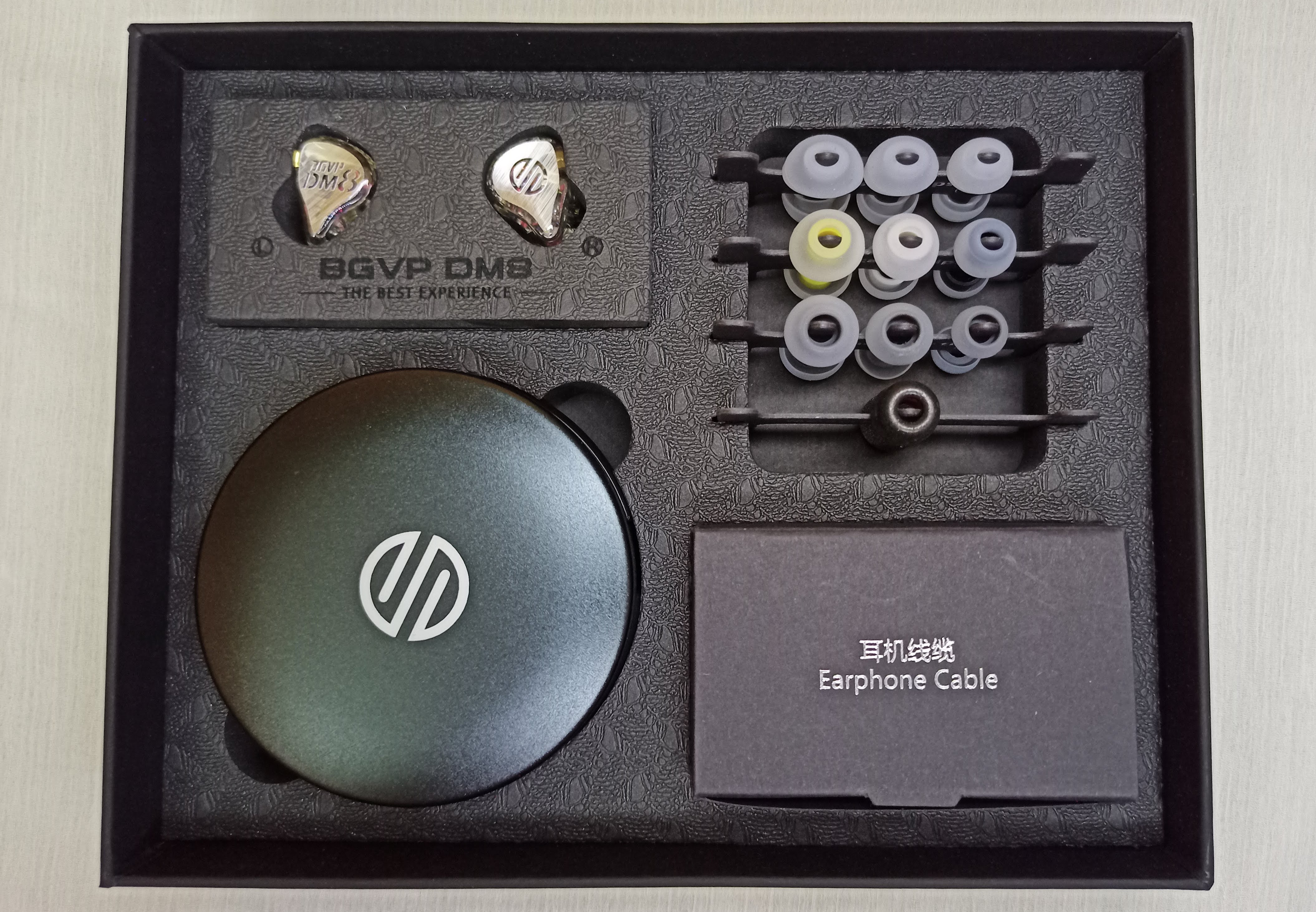
Sound :
Bass:
The bass extension is abnormally good for a BA, it feels like a DD. The subbass is deep and tight, and DM8 has firm grasp over it, never losing control, never sounding loose or limp.
I haven't heard such great extension and punch off a BA as of writing this review. The subbass will force you to recalibrate your brain regarding what a BA can do.
It focuses on more on speed, texture, information and tightness than quantity which I personally prefer, even more so as I consider the bass quantity on DM8 to be optimum i.e of perfect quantity.
Even considering my bias for this tasty bass response, it is indeed boosted compared to "neutral" but not by much.

Midrange :
The upper midrange is bity and crispy. It isn't aggressive to me but it is getting right up to the limit, do note that I tend to prefer some more energy in the upper midrange than others usually. It might also be fatiguing for long listening sessions if you're sensitive.
So the upper midrange might sound a bit aggressive to others. The rest of the midrange I find fairly balanced with correct tonality. No issues in tonality with male vocals but due to the hot upper midrange, female vocals can come out to be sharp sometimes, specially on intimate recordings.
I find the detail retrieval in this range to be better than in the top end, micro-details and spatial cues are resolved with ease.
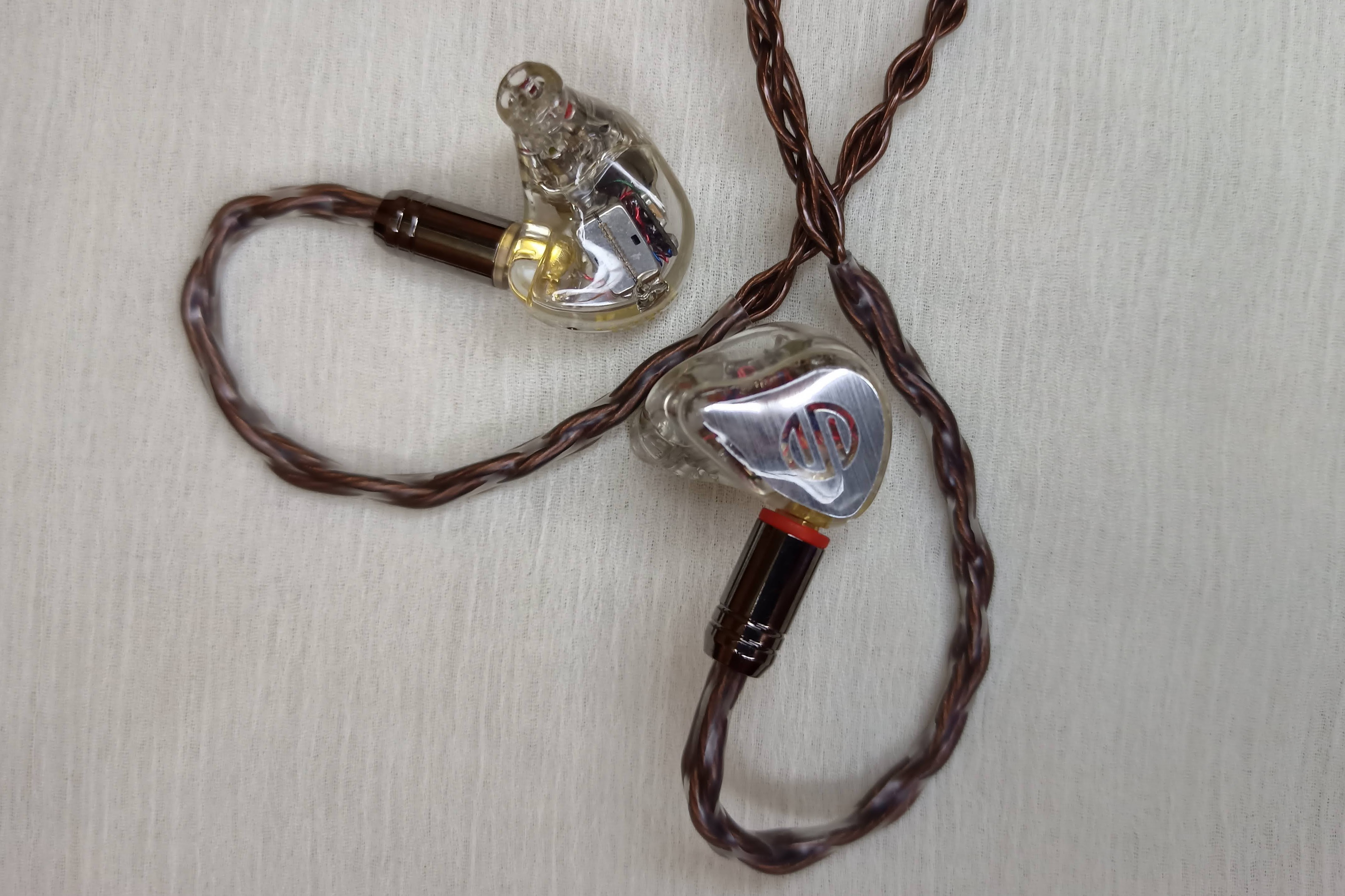
Treble :
The tuning in treble is played safe, there is not much emphasis on the mid-treble. I see this trend repeated across many brands and I see why they do it (to avoid sibilance, excess sparkle or harshness), the DM8 is no exception. This left me wanting a bit more as the IEM is very capable all things considered.
However, when it comes to the upper treble, it redeems itself with sufficient sparkle, brilliance and brimming with energy, neither does it feel closed in nor is it harsh. The airy and atmospheric upper-treble makes up for the tamed mid treble and the overall experience is balanced, all things considered.
The lower treble is free from spikes which is good news for compressed recordings/genres in general, with no harshness or tonality issues to speak of. The DM8's treble tuning is miles ahead compared to the DM6, which was very aggressive and harsh to my ears.

Soundstage & Imaging :
The imaging is class leading, it runs circles around the dt880 600 ohms which is already some of the best imaging headphones out there. I've rarely seen such a continuous soundscape from an IEM, bravo BGVP.
The soundstage is more wide and tall than deep. The center image's vertical height is locked on straight, and aided with some good height, the soundstage is tall and wide.
Unfortunately, the depth is not much to speak of. It ain't bad, but I have heard better for cheaper.
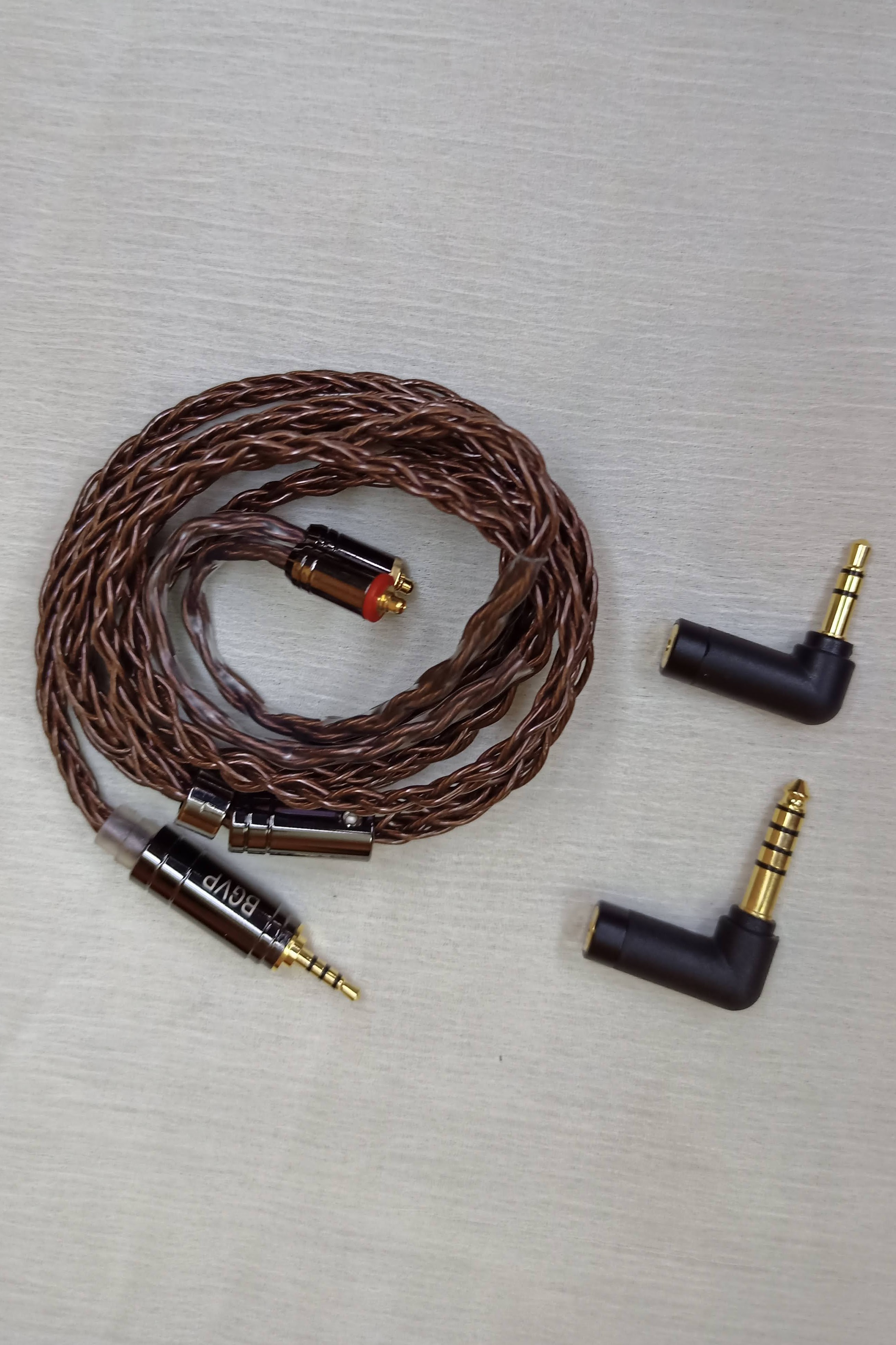
Dynamics :
Holy mother! I am predominantly a headphone user and the DM8 has better macro-dynamics than all my headphones (AKG K361, HD6XX, AKG K712, DT880 600 ohms, AKG K240 Sextett) driven off a desktop amp.
Listening to Dawn Chorus by Conforce, I was finally able to appreciate it in its full glory. Surreal macrodynamics for an IEM, so much so that it might get overwhelming sometimes, like recordings similar to Dawn Chorus.
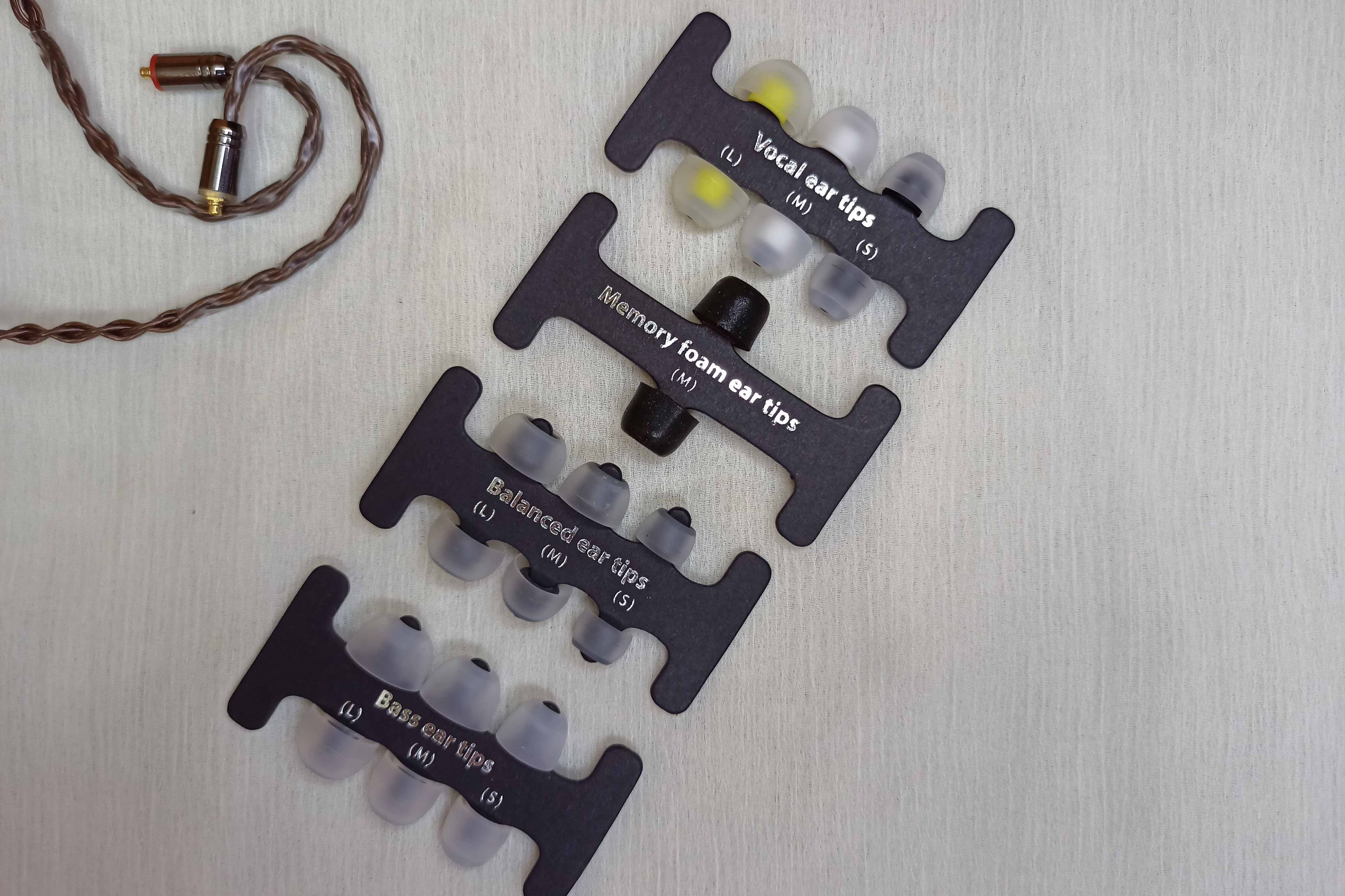
Conclusion :
350 USD isn't exactly in the budget range for many people, but it is hard not to recommend the DM8. It is a potent player in the mid-fi range competing even with mid-fi headphones and outplaying it.

We have the transparent clear variant here for review and it is beautiful. But what's even prettier is the cable. It is a thiccc frozen UPOCC 6N 8-strand single crystal copper 24awg cable. The Litz structure is made by hand according to BGVP.
It is a heavy cable and the connector plugs are solid chunks of metal, which can even be used to hurt people. Every component of the cable screams quality and truly high-end. It is a balanced cable in stock form and you get 2 adapters, one to 3.5mm SE and another to 4.4mm BAL.
The cable is so thiccc that the DM8 barely fits in the included metal carry case. There won't be any space to keep the adapters inside.
Coming back to the shell, it's always fun to be able to see what's inside. The 4 pairs of BA and even the crossover board. Each pair of BA having their own bore, the DM8 being a quad bore. Fun stuff.
The shell is smaller than the Moondrop Blessing 2 and I didn't find the DM8 to be uncomfrotable. You get a wide assortment of tips too to tune the sound (Balanced, Vocal, Bass and Foam). Review conducted on Balanced tips.

Amp Needs :
Rated at 12 ohm at 110 dB/mW, DM8 is very efficient and can be run off phones. But if you're using a 350$ IEM, I'd expect you to have a good source to take advantage of this IEM.
Explicitly speaking, no external amp is needed.

Sound :
Bass:
The bass extension is abnormally good for a BA, it feels like a DD. The subbass is deep and tight, and DM8 has firm grasp over it, never losing control, never sounding loose or limp.
I haven't heard such great extension and punch off a BA as of writing this review. The subbass will force you to recalibrate your brain regarding what a BA can do.
It focuses on more on speed, texture, information and tightness than quantity which I personally prefer, even more so as I consider the bass quantity on DM8 to be optimum i.e of perfect quantity.
Even considering my bias for this tasty bass response, it is indeed boosted compared to "neutral" but not by much.

Midrange :
The upper midrange is bity and crispy. It isn't aggressive to me but it is getting right up to the limit, do note that I tend to prefer some more energy in the upper midrange than others usually. It might also be fatiguing for long listening sessions if you're sensitive.
So the upper midrange might sound a bit aggressive to others. The rest of the midrange I find fairly balanced with correct tonality. No issues in tonality with male vocals but due to the hot upper midrange, female vocals can come out to be sharp sometimes, specially on intimate recordings.
I find the detail retrieval in this range to be better than in the top end, micro-details and spatial cues are resolved with ease.

Treble :
The tuning in treble is played safe, there is not much emphasis on the mid-treble. I see this trend repeated across many brands and I see why they do it (to avoid sibilance, excess sparkle or harshness), the DM8 is no exception. This left me wanting a bit more as the IEM is very capable all things considered.
However, when it comes to the upper treble, it redeems itself with sufficient sparkle, brilliance and brimming with energy, neither does it feel closed in nor is it harsh. The airy and atmospheric upper-treble makes up for the tamed mid treble and the overall experience is balanced, all things considered.
The lower treble is free from spikes which is good news for compressed recordings/genres in general, with no harshness or tonality issues to speak of. The DM8's treble tuning is miles ahead compared to the DM6, which was very aggressive and harsh to my ears.

Soundstage & Imaging :
The imaging is class leading, it runs circles around the dt880 600 ohms which is already some of the best imaging headphones out there. I've rarely seen such a continuous soundscape from an IEM, bravo BGVP.
The soundstage is more wide and tall than deep. The center image's vertical height is locked on straight, and aided with some good height, the soundstage is tall and wide.
Unfortunately, the depth is not much to speak of. It ain't bad, but I have heard better for cheaper.

Dynamics :
Holy mother! I am predominantly a headphone user and the DM8 has better macro-dynamics than all my headphones (AKG K361, HD6XX, AKG K712, DT880 600 ohms, AKG K240 Sextett) driven off a desktop amp.
Listening to Dawn Chorus by Conforce, I was finally able to appreciate it in its full glory. Surreal macrodynamics for an IEM, so much so that it might get overwhelming sometimes, like recordings similar to Dawn Chorus.

Conclusion :
350 USD isn't exactly in the budget range for many people, but it is hard not to recommend the DM8. It is a potent player in the mid-fi range competing even with mid-fi headphones and outplaying it.

Last edited:
Dsnuts
Headphoneus Supremus
Pros: Excellent museum like build quality, great accessories package, ample variety of tips, 6N OCC pure copper cable which matches up well with the sonics of the DM8.
Highly resolving, dimensional, rich in tone. DM8 is a well designed high in SQ and value. Excellent choice of premium BAs. 5 Knowles and 3 Sonion BAs, 4 crossovers with 4 sound bores out the nozzle. One of the best all BA bass earphones I can think of. Above average passive isolation, very good imaging, layering with a spacious deep and wide stage, ideal instrument separation and detail. Technical yet fun sound tuning, very engaging sound signature. Easy to drive but not a hiss magnet. Scales extremely well with your aftermarket higher end cables. These will make you wonder why your other all BA earphones cost so much making the DM8 one of the best value earphones in the market at its price range.
Highly resolving, dimensional, rich in tone. DM8 is a well designed high in SQ and value. Excellent choice of premium BAs. 5 Knowles and 3 Sonion BAs, 4 crossovers with 4 sound bores out the nozzle. One of the best all BA bass earphones I can think of. Above average passive isolation, very good imaging, layering with a spacious deep and wide stage, ideal instrument separation and detail. Technical yet fun sound tuning, very engaging sound signature. Easy to drive but not a hiss magnet. Scales extremely well with your aftermarket higher end cables. These will make you wonder why your other all BA earphones cost so much making the DM8 one of the best value earphones in the market at its price range.
Cons: Included cable is 2.5mm out with 2 adapters 3.5mm single and 4.4mm balanced. This works but not exactly modular. Slight metallic treble tone. Bass might be a bit much for neutral heads. Just when you thought you heard the best in the $300 range here comes the DM8.
BGVP DM8

All BA designs have been one of the mainstays of the in ear monitor, with ever increasing competition the chi fi market has seen so many variations of the all BA designs. BGVP has been making earphones with value in mind for the past 10 years and I have to say their newest creation in the DM8 is just this. A clear value statement.
The DM8 is based on traditional All BA flagship formulas for BA sets and BGVP seems to keep improving on their designs. The DM8 gets extra BAs from their previous efforts the DM6, DM7 and now in the DM8. At the heart of the design BGVP is using 5 knowles and 3 Sonion BA drivers inside the DM8. While this information is correct as BGVP is guilty of marketing the dual BAs as 2 BAs in reality it is taking the space of a single BA. Advantage of using dual BAs is to save on some internal space of the housing. Several of the drivers being used stacks 2 BA with one sound nozzle.
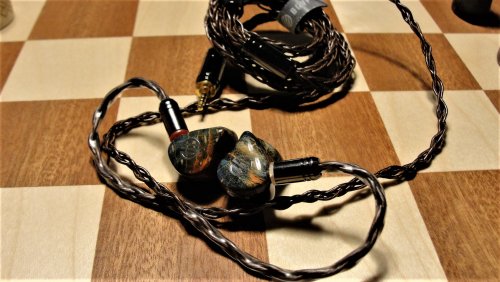
What does dual BAs do better than a well implemented single BA? To be honest I have no idea. It makes it more marketable to say you're using 2 BAs for a single region of sound I suppose. With today's driver wars, more the merrier right? In any case for this reviewer. I really can’t tell the difference between the touted 8 driver BA configuration vs a well designed 5-6 driver one. As they say it all depends on implementation. In any case just because these multi driver BA configurations are using more and more BAs it does not mean your getting an increase in sonics.
In my assessment of the multi BA designs. To get the best of the multi BA design to cover the full spectrum of sound correctly I would say a minimum of 3BAs are needed. Yes there are single and dual BAs that do extremely well and I have reviewed those but there is a difference between a well designed single BA design vs a well designed 3 BA design. From the 3 BA design added BAs on top of that gives you slight incremental refinements in the given regions of sound. Deeper better extended bass, better layering of sound, more dimensional imaging, better extended treble with an increase of detail and dynamics. But it gets to a certain point in the game where too much is too much and does not show a clear advantage from them added BAs.
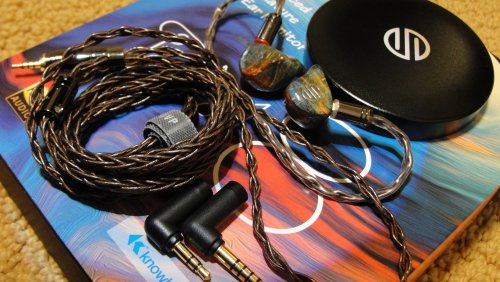
Case in point I own a 14BA iem with 7 crossovers and used to cost over 2K in price and to be honest it lacks bass extension that I only wish was like the bass in the DM8. The DM8 in this case sounds not only more complete but sounds just as good in the other frequencies as this 14BA iem. It comes down to that implementation and tuning.
Back to the task at hand, DM8 from the get go is showing some serious sound chops and that is what this read is about and the design is outstanding. Currently there are 2 different options. One in a clear resin shell and one in a stabilized wood.

The BUILD:
Nothing wrong with the clear resin design but not often you're gonna get a one of kind stabilized wood housing for your 8 BA earphones. They are great to look at and the wood finish on the shells make them look like museum pieces. BGVP did well with this design, to my surprise the housing is not huge. I would consider it medium in shape and form. Considering this is packing all that iron in the housing, they must have utilized every part of this housing to fit them drivers.
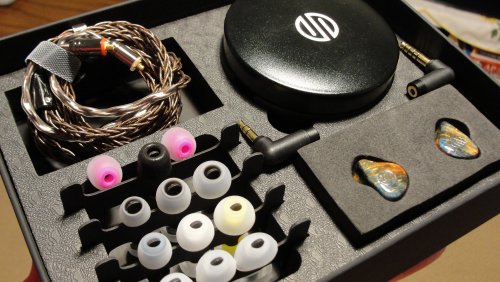
It comes with an above average selection of tips and a thicker 8 cored 6n OCC copper cable, a great choice for all BA earphones. I am thinking BGVP learned a thing or two from previous offerings and the online chatter about cable upgrades and the cable of choice for their previous DM6 was pure copper cables. What is included is certainly a good solid copper cable and brings a slight warm tilt to the sonics with a bit more emphasis toward bass and mids. For a throw in cable these are actually very nice and match up well with the sonic ability of the DM8. However I am a cable guy and I will say the DM8 benefits greatly with nicer more resolving upgraded aftermarket cables.

The packed in 8 core mmcx copper cable comes terminated in 2.5mm balanced, which is not too common for a pack in cable. Then they included some adapters to use; a single ended 3.5mm and a 4.4mm balanced adapter. This is a cheaper but effective method so you can use this particular cable on all types of DAPs and sources, not exactly modular but it works nonetheless. For a case they included the all aluminum round canister. I do like the aluminum canister more so than the standard zip up case. The canister is barely big enough for the earphones and cable but does the job to protect your investment. I noticed the entire packaging is a thinner rectangular box. I suppose throwing in anything larger would have made it difficult for a tidy package.

The tips in the package include 3 sets of silicones and a set of medium foams. Each set of silicone tips are labeled. One set for balanced,one set for vocals and the last set for bass. In trying out the included tips they all work well enough but I found the widest bored balanced tips gives the best overall ability on the earphones with the vocal tips having a medium sized nozzle had minimal differences from the balanced tips. The bass tips actually made the biggest difference going from the balanced tips. It does accentuate the bass using a narrow 3mm bore. Fun sounding yes but not the best for other frequencies. Overall I would say the accessories shows a well thought out package.
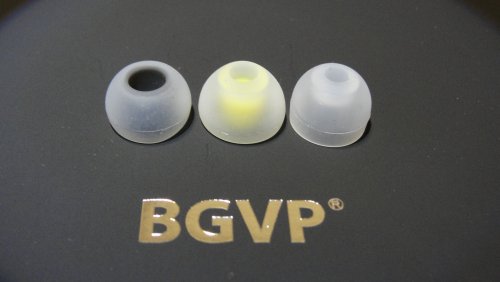
From left to right. Balanced, vocal, bass tips.
The DISCLAIMER.
I would like to thank the Beteran group on aliexpress, for a chance to review the BGVP DM8. I was given the DM8 for a discount in exchange for my take on the DM8. You can purchase the DM8 on this site here and here.
The SOUND.
Sound analysis was done using my various sources the Fiio M15, Shanling M6 pro, M5s, M3s, Ibasso DX160, Sony ZX300, Cayin N5ii and IFI black label for amping.

DM8 is BGVPs 3rd all BA design and one that will be a crowd pleaser. The sound design is a balanced mix of one part fun, one part technical and a bit of the analytical in sound design all encompassed in a hard stabilized wood design. It utilizes 4 crossovers with sound channeling through 4 sound bores out the nozzle. Clear separation and coherency is the end result of this design. What is interesting for this particular model is the drivers chosen to do the mids, one Sonion and one Knowles, the best of both worlds. Sonion BAs are known for their rich smooth tone, Knowles known for their precision and detail. I do believe BGVP is the first to integrate both types of BAs to the most important aspect of the sound design. This implementation alone had me curious about the DM8 from the start.
The DM8 is a highly technical V shaped BGVP house tuned designed with emphasis peaks at 50 hz for bass and 7khz for treble seeing a roughly 12dbs of pinna gain in the upper mids. The sound is relatively balanced and with a good healthy amount of bass impact and emphasis which brings a slight warm tilt to tonality and also sees a good amount of treble presence which does the job for the clear precise nature of the sound tuning.

The FUN.
What good is your music if you don’t have any fun listening. Using a larger vented Sonion dual BAs for bass. Bass is stellar for BA designs. I have seen a trend lately and for good reason. BGVP is one of several manufacturers using the Sonion BAs for bass recently. Your bass tracks actually sounds like really good quality bass. Surprising coming from a BA as it has been generally known BAs don’t do bass quite like a good dynamic driver. Yes but these BAs are excellent for bass and it shows. I had the opportunity to review another all BA IEM in the newer DUNU SA6 and I do believe BGVP is using a very similar vented acupass dual Sonion BA drivers for bass. They look identical and actually sound identical in the bass ability. Not a 100% certain but I will assume it is of similar or possibly the same drivers. I also reviewed several Tansio Mirai all BA earphones that utilize Sonion BAs for bass. The one thing I am certain of, Sonion seems to be preferable for BA bass for BA designs nowadays with all the other earphones mentioned and in the DM8.
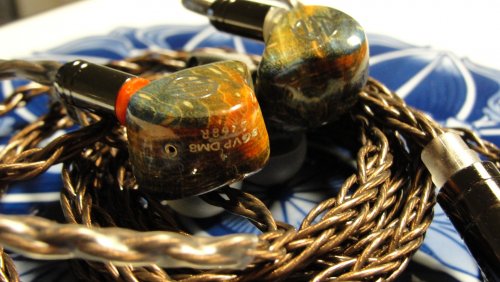
Bass is about as good as you're gonna get for BA bass. Digs deep and rumbles like a vented driver should. Bass impact is not only impressive here, It is tonally accurate and the one benefit that BA bass presents with is tightness and speed. You're gonna get a tight, accurate, impactful, speedy and deep reaching bass end in the DM8. What is really impressive here is just how natural bass sounds on the DM8 with its medium amount of decay and quick agility. If it is in the recording you're gonna hear it and that is pretty awesome for BA bass to produce. More than capable the bass from the DM8 has great ability and will bring forth the type of bass you would expect from a higher end sound.

The TECHNICAL.
Mid bands take a slight step back from the impactful bass but that bodes well for bass infused genres for music.Utilizing one Sonion BA and another Knowles BA for the mid bands. The idea there is that these two will bring the best of both houses infused for an overall engaging mids presentation. One half rich and smooth with the other half being clean and precise. Mids have an overall clean body of note and has good weight to the sonics. Imaging is excellent here utilizing both houses strengths with a clean sound separation, rich in detail that has good layering with an excellent sense of depth for in ears. Overall stage I would say is above average sideways oval with a deeper than higher stage presentation, the 4 sound bores presents a clean separation of the frequencies yet sounding impressively coherent at the same time.

Vocals don’t sound forward in the mix but has good presence and don’t sound distant. I do detect a slight bias toward male vocals vs female emphasis but not a large difference in presence. Instrument timbre is decisively BA be it good or bad depending on your sonic preference. The dimensional imaging and very good instrument separation helps your music pop and overall I would say the mid bands sounds engaging and shows a very good resolving ability. The tuning is again fairly balanced for a V shaped tuning and I feel BGVP squeezed all they could from these drivers in unison however somehow I feel they could have gotten a bit more from the mids drivers in pushing the mid bands a touch more forward, for the given price however, mids sound great and does show a bit of both Sonion and Knowles strengths.

The ANALYTICAL.
Treble has main focus in the mid treble presence area with a peak around 7khz. This brings a lot of clarity and detail to the rest of the sound bands and the DM8 does a good job not to fatigue. While the treble here could have better balance, it does show a good controlled treble end. BA precision and strength lies in the mid to treble bands. Treble tone for the treble area can come off a touch metallic. Treble for the most part is clean with good rangy detail and imaging but does come off a bit shiny in presentation not to a degree that it interferes with cohesion or cause fatigue but I have noticed the upper treble tweeters that seem to stand by itself on certain tracks. This was noticed only on a few tracks so not a deal breaker.
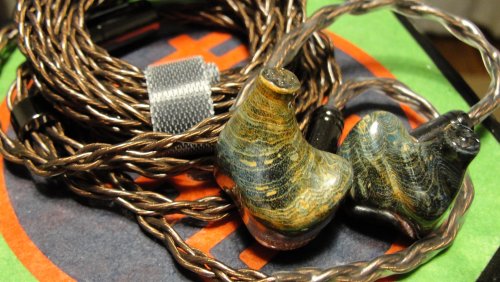
Treble could do with a bit more refinement and smoothening. For folks that like them some treble sparkle the DM8 has that sparkle and a good amount of shimmer. Again dependent on a person's taste on how they like their treble. Treble has solid presence, clarity with good definition and separation with quick transients for the highs, but comes with it a slight metallic tinge in tone. The treble end has a bit of BA coloration, is nicely extended showing plenty of ability in the region but is not the most natural sounding. Treble could use a bit more smoother presentation but I look at this treble presentation as a BGVP house tuning thing. They seem to always include some type of treble sparkle in all their earphones. Sparkle is a valid house sound trait, I can go with that.
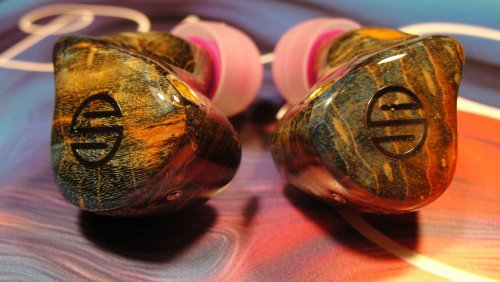
Sound design comes down to the Bass, then treble, then the mids in presentation but overall sounds musical yet dimensionally technical in performance.

The VERDICT.
BGVP did very good with this particular design. Not too many quad bored 4 crossover 8 BA iem in all stabilized wood housing that uses 5 knowles and 3 Sonion BAs with a price tag that isn’t gonna require a 2nd mortgage. In fact DM8 would be the first for this particular design at this price. Something similar to this design and sound would have been a top of the line flagship level earphone 4 years ago with a price to match. Beyond the beautiful shells, the package and the high level sound quality, these are clearly pushing a value statement and might even be the bench for value at the price level. I really can't find too much fault with the entire package. They are easy to drive, isolate well, come with a well thought out accessories package and most importantly has an exceptionally engaging sound. This is one brand to look out for as they seem to be getting better with each new design they make. Thanks for reading and as always happy listening.

All BA designs have been one of the mainstays of the in ear monitor, with ever increasing competition the chi fi market has seen so many variations of the all BA designs. BGVP has been making earphones with value in mind for the past 10 years and I have to say their newest creation in the DM8 is just this. A clear value statement.
The DM8 is based on traditional All BA flagship formulas for BA sets and BGVP seems to keep improving on their designs. The DM8 gets extra BAs from their previous efforts the DM6, DM7 and now in the DM8. At the heart of the design BGVP is using 5 knowles and 3 Sonion BA drivers inside the DM8. While this information is correct as BGVP is guilty of marketing the dual BAs as 2 BAs in reality it is taking the space of a single BA. Advantage of using dual BAs is to save on some internal space of the housing. Several of the drivers being used stacks 2 BA with one sound nozzle.

What does dual BAs do better than a well implemented single BA? To be honest I have no idea. It makes it more marketable to say you're using 2 BAs for a single region of sound I suppose. With today's driver wars, more the merrier right? In any case for this reviewer. I really can’t tell the difference between the touted 8 driver BA configuration vs a well designed 5-6 driver one. As they say it all depends on implementation. In any case just because these multi driver BA configurations are using more and more BAs it does not mean your getting an increase in sonics.
In my assessment of the multi BA designs. To get the best of the multi BA design to cover the full spectrum of sound correctly I would say a minimum of 3BAs are needed. Yes there are single and dual BAs that do extremely well and I have reviewed those but there is a difference between a well designed single BA design vs a well designed 3 BA design. From the 3 BA design added BAs on top of that gives you slight incremental refinements in the given regions of sound. Deeper better extended bass, better layering of sound, more dimensional imaging, better extended treble with an increase of detail and dynamics. But it gets to a certain point in the game where too much is too much and does not show a clear advantage from them added BAs.

Case in point I own a 14BA iem with 7 crossovers and used to cost over 2K in price and to be honest it lacks bass extension that I only wish was like the bass in the DM8. The DM8 in this case sounds not only more complete but sounds just as good in the other frequencies as this 14BA iem. It comes down to that implementation and tuning.
Back to the task at hand, DM8 from the get go is showing some serious sound chops and that is what this read is about and the design is outstanding. Currently there are 2 different options. One in a clear resin shell and one in a stabilized wood.

The BUILD:
Nothing wrong with the clear resin design but not often you're gonna get a one of kind stabilized wood housing for your 8 BA earphones. They are great to look at and the wood finish on the shells make them look like museum pieces. BGVP did well with this design, to my surprise the housing is not huge. I would consider it medium in shape and form. Considering this is packing all that iron in the housing, they must have utilized every part of this housing to fit them drivers.

It comes with an above average selection of tips and a thicker 8 cored 6n OCC copper cable, a great choice for all BA earphones. I am thinking BGVP learned a thing or two from previous offerings and the online chatter about cable upgrades and the cable of choice for their previous DM6 was pure copper cables. What is included is certainly a good solid copper cable and brings a slight warm tilt to the sonics with a bit more emphasis toward bass and mids. For a throw in cable these are actually very nice and match up well with the sonic ability of the DM8. However I am a cable guy and I will say the DM8 benefits greatly with nicer more resolving upgraded aftermarket cables.

The packed in 8 core mmcx copper cable comes terminated in 2.5mm balanced, which is not too common for a pack in cable. Then they included some adapters to use; a single ended 3.5mm and a 4.4mm balanced adapter. This is a cheaper but effective method so you can use this particular cable on all types of DAPs and sources, not exactly modular but it works nonetheless. For a case they included the all aluminum round canister. I do like the aluminum canister more so than the standard zip up case. The canister is barely big enough for the earphones and cable but does the job to protect your investment. I noticed the entire packaging is a thinner rectangular box. I suppose throwing in anything larger would have made it difficult for a tidy package.

The tips in the package include 3 sets of silicones and a set of medium foams. Each set of silicone tips are labeled. One set for balanced,one set for vocals and the last set for bass. In trying out the included tips they all work well enough but I found the widest bored balanced tips gives the best overall ability on the earphones with the vocal tips having a medium sized nozzle had minimal differences from the balanced tips. The bass tips actually made the biggest difference going from the balanced tips. It does accentuate the bass using a narrow 3mm bore. Fun sounding yes but not the best for other frequencies. Overall I would say the accessories shows a well thought out package.

From left to right. Balanced, vocal, bass tips.
The DISCLAIMER.
I would like to thank the Beteran group on aliexpress, for a chance to review the BGVP DM8. I was given the DM8 for a discount in exchange for my take on the DM8. You can purchase the DM8 on this site here and here.
The SOUND.
Sound analysis was done using my various sources the Fiio M15, Shanling M6 pro, M5s, M3s, Ibasso DX160, Sony ZX300, Cayin N5ii and IFI black label for amping.

DM8 is BGVPs 3rd all BA design and one that will be a crowd pleaser. The sound design is a balanced mix of one part fun, one part technical and a bit of the analytical in sound design all encompassed in a hard stabilized wood design. It utilizes 4 crossovers with sound channeling through 4 sound bores out the nozzle. Clear separation and coherency is the end result of this design. What is interesting for this particular model is the drivers chosen to do the mids, one Sonion and one Knowles, the best of both worlds. Sonion BAs are known for their rich smooth tone, Knowles known for their precision and detail. I do believe BGVP is the first to integrate both types of BAs to the most important aspect of the sound design. This implementation alone had me curious about the DM8 from the start.
The DM8 is a highly technical V shaped BGVP house tuned designed with emphasis peaks at 50 hz for bass and 7khz for treble seeing a roughly 12dbs of pinna gain in the upper mids. The sound is relatively balanced and with a good healthy amount of bass impact and emphasis which brings a slight warm tilt to tonality and also sees a good amount of treble presence which does the job for the clear precise nature of the sound tuning.

The FUN.
What good is your music if you don’t have any fun listening. Using a larger vented Sonion dual BAs for bass. Bass is stellar for BA designs. I have seen a trend lately and for good reason. BGVP is one of several manufacturers using the Sonion BAs for bass recently. Your bass tracks actually sounds like really good quality bass. Surprising coming from a BA as it has been generally known BAs don’t do bass quite like a good dynamic driver. Yes but these BAs are excellent for bass and it shows. I had the opportunity to review another all BA IEM in the newer DUNU SA6 and I do believe BGVP is using a very similar vented acupass dual Sonion BA drivers for bass. They look identical and actually sound identical in the bass ability. Not a 100% certain but I will assume it is of similar or possibly the same drivers. I also reviewed several Tansio Mirai all BA earphones that utilize Sonion BAs for bass. The one thing I am certain of, Sonion seems to be preferable for BA bass for BA designs nowadays with all the other earphones mentioned and in the DM8.

Bass is about as good as you're gonna get for BA bass. Digs deep and rumbles like a vented driver should. Bass impact is not only impressive here, It is tonally accurate and the one benefit that BA bass presents with is tightness and speed. You're gonna get a tight, accurate, impactful, speedy and deep reaching bass end in the DM8. What is really impressive here is just how natural bass sounds on the DM8 with its medium amount of decay and quick agility. If it is in the recording you're gonna hear it and that is pretty awesome for BA bass to produce. More than capable the bass from the DM8 has great ability and will bring forth the type of bass you would expect from a higher end sound.

The TECHNICAL.
Mid bands take a slight step back from the impactful bass but that bodes well for bass infused genres for music.Utilizing one Sonion BA and another Knowles BA for the mid bands. The idea there is that these two will bring the best of both houses infused for an overall engaging mids presentation. One half rich and smooth with the other half being clean and precise. Mids have an overall clean body of note and has good weight to the sonics. Imaging is excellent here utilizing both houses strengths with a clean sound separation, rich in detail that has good layering with an excellent sense of depth for in ears. Overall stage I would say is above average sideways oval with a deeper than higher stage presentation, the 4 sound bores presents a clean separation of the frequencies yet sounding impressively coherent at the same time.

Vocals don’t sound forward in the mix but has good presence and don’t sound distant. I do detect a slight bias toward male vocals vs female emphasis but not a large difference in presence. Instrument timbre is decisively BA be it good or bad depending on your sonic preference. The dimensional imaging and very good instrument separation helps your music pop and overall I would say the mid bands sounds engaging and shows a very good resolving ability. The tuning is again fairly balanced for a V shaped tuning and I feel BGVP squeezed all they could from these drivers in unison however somehow I feel they could have gotten a bit more from the mids drivers in pushing the mid bands a touch more forward, for the given price however, mids sound great and does show a bit of both Sonion and Knowles strengths.

The ANALYTICAL.
Treble has main focus in the mid treble presence area with a peak around 7khz. This brings a lot of clarity and detail to the rest of the sound bands and the DM8 does a good job not to fatigue. While the treble here could have better balance, it does show a good controlled treble end. BA precision and strength lies in the mid to treble bands. Treble tone for the treble area can come off a touch metallic. Treble for the most part is clean with good rangy detail and imaging but does come off a bit shiny in presentation not to a degree that it interferes with cohesion or cause fatigue but I have noticed the upper treble tweeters that seem to stand by itself on certain tracks. This was noticed only on a few tracks so not a deal breaker.

Treble could do with a bit more refinement and smoothening. For folks that like them some treble sparkle the DM8 has that sparkle and a good amount of shimmer. Again dependent on a person's taste on how they like their treble. Treble has solid presence, clarity with good definition and separation with quick transients for the highs, but comes with it a slight metallic tinge in tone. The treble end has a bit of BA coloration, is nicely extended showing plenty of ability in the region but is not the most natural sounding. Treble could use a bit more smoother presentation but I look at this treble presentation as a BGVP house tuning thing. They seem to always include some type of treble sparkle in all their earphones. Sparkle is a valid house sound trait, I can go with that.

Sound design comes down to the Bass, then treble, then the mids in presentation but overall sounds musical yet dimensionally technical in performance.

The VERDICT.
BGVP did very good with this particular design. Not too many quad bored 4 crossover 8 BA iem in all stabilized wood housing that uses 5 knowles and 3 Sonion BAs with a price tag that isn’t gonna require a 2nd mortgage. In fact DM8 would be the first for this particular design at this price. Something similar to this design and sound would have been a top of the line flagship level earphone 4 years ago with a price to match. Beyond the beautiful shells, the package and the high level sound quality, these are clearly pushing a value statement and might even be the bench for value at the price level. I really can't find too much fault with the entire package. They are easy to drive, isolate well, come with a well thought out accessories package and most importantly has an exceptionally engaging sound. This is one brand to look out for as they seem to be getting better with each new design they make. Thanks for reading and as always happy listening.
Last edited:
Dsnuts
Dunu SA6 has better balance and a better tonality especially for treble, but technically the DM8 is right up there with the SA6. Which is saying something as the DM8 is much cheaper. Value on the DM8 is very high imo.
CT007
I'm trying to choose 2 all-rounder competitors to test against FD5(probably LZ A7 and DM8), that have bass quality & quantity at least at FH3 level. Do you find any treble fatigue on FD5/DM8? How is the fit of both? Which has better bass? Ultimately, which would you choose with only stock components?
Leonne
compare to Blessing 2 pls?



